Paul van Yperen's Blog, page 207
February 6, 2020
Kirk Douglas (1916-2019)
Cleft-chinned and steely-eyed American superstar Kirk Douglas (1916) passed away on 5 February 2020 in Los Angeles, at the age of 103. The legendary actor, producer and director made his film debut in The Strange Love of Martha Ivers (1946) with Barbara Stanwyck. Douglas soon developed into a leading box-office star throughout the 1950s, known for serious dramas, Westerns and war films. Our favourites are the two classics he made with Stanley Kubrick, Paths of Glory (1957) and Spartacus (1960). During his long career, he appeared in more than 90 films. Mr. Douglas, rest in peace, EFSP salutes you.
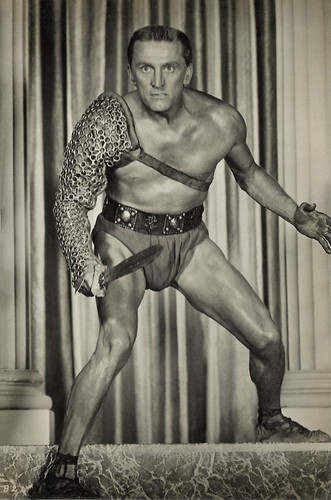
Spanish postcard by Archivo Bermejo, no. 7143. Photo: Universal International, 1960. Kirk Douglas in Spartacus (Stanley Kubrick, 1960).
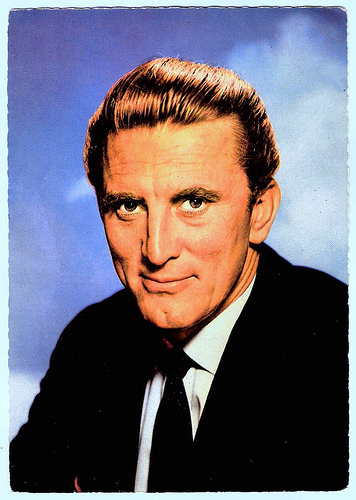
German postcard by ISV, no. A 42. Photo: 20th Century Fox. Publicity still for The Racers (Henry Hathaway, 1955).
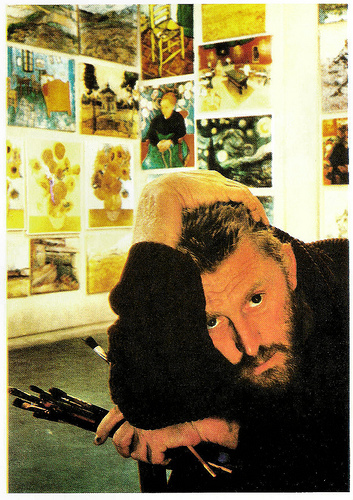
French postcard in the Collection Cinema Couleur by Editions La Malibran, Paris/Nancy, 1989. Photo: John Bryson. Publicity still for Lust for Life (Vincente Minnelli, 1956).
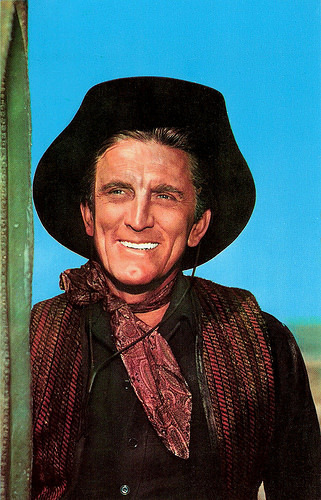
Israelian postcard by Editions de Luxe. Photo: publicity still for The Last Sunset (Robert Aldrich, 1961).
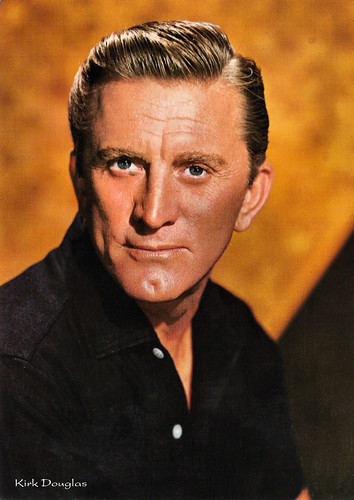
Italian postcard by in the Artisti di Sempre series by Rotalfoto, Milano, no. 297.
The ragman's son
Kirk Douglas was born as 'the ragman's son' (the name of his 1988 autobiography) known as Issur Danielovitch Demsky, in Amsterdam, New York, in 1916. His parents, Bryna (Sanglel) and Herschel Danielovitch, were Jewish immigrants from Chavusy, Mahilyow Voblast (now in Belarus). Kirk had six sisters.
Growing up in a poor ghetto, 'Izzy' Demsky sold snacks to mill workers and delivered newspapers to earn enough to buy milk and bread to help his family. He was a fine student and wrestled competitively during his time at St. Lawrence University. He worked at more than forty different jobs before getting an acting job. The American Academy of Dramatic Arts gave him a special scholarship, but he only appeared in a handful of minor Broadway productions before joining the US Navy in 1941. He then legally changed his name to Kirk Douglas.
After the war, Douglas returned to New York City and found work in radio, theatre and commercials. His stage break occurred in Kiss and Tell, which led to other roles. On the insistence of ex-classmate Lauren Bacall producer Hal B. Wallis screen-tested Douglas and cast him opposite Barbara Stanwyck in The Strange Love of Martha Ivers (Lewis Milestone, 1946). He played a young, insecure man, stung with jealousy, whose life was dominated by a ruthless older woman, and he hid his feelings with alcohol. It would be the last time that Douglas portrayed a weakling in a film role.
His performance received rave reviews and further work quickly followed, including an appearance in the Film Noir I walk alone(Byron Haskin, 1948). It was the first time he worked alongside Burt Lancaster . They appeared in seven films together, including the dynamic western Gunfight at the O.K. Corral (John Sturges, 1957), the John Frankenheimer political thriller Seven Days in May (1964) and their final pairing in the gangster comedy Tough Guys (Jeff Kanew, 1986).
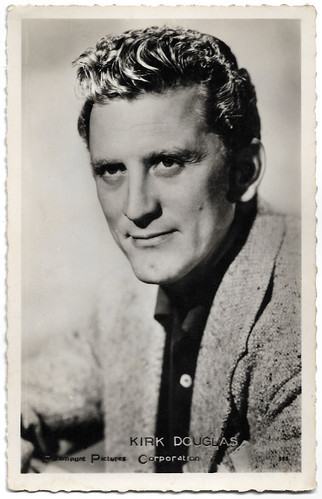
French postcard by Editions P.I., Paris, no. 393. Photo: Paramount Pictures Corporation.
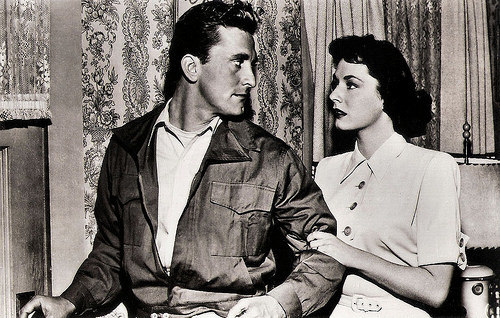
Spanish postcard by Soberanas, no. 280. Photo: publicity still for Champion (Mark Robson, 1949) with Ruth Roman.

Dutch card. Photo: Warner Bros. Doris Day and Kirk Douglas in Young Man with a Horn (Michael Curtiz, 1950).
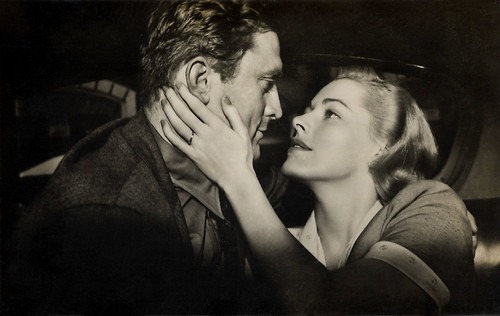
Spanish postcard by JDP, Valencia, no. 1375. Photo: Kirk Douglas and Eleanor Parker in Detective Story (William Wyler, 1951).
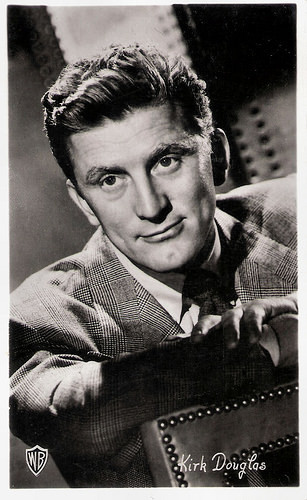
Belgian collectors card by De Beukelaer, Antwerp, no A 43. Photo: Warner Bros.
Vincent van Gogh
Douglas scored his first Oscar nomination playing the tough, unscrupulous boxing hero Midge Kelly in the gripping The Champion (Mark Robson, 1949). His acting style, relying on expressing great concentration, realism, and powerful emotions, made him a star. Among his early films were the musical drama Young Man with a Horn (Michael Curtiz, 1950) opposite Lauren Bacall, Billy Wilder's Film Noir on the press Ace in the Hole (1951) which won a best foreign film award at the Venice Film Festival, and the Film Noir Detective Story (William Wyler, 1951), nominated for four Academy Awards.
The quality of his work continued to garner the attention of critics. He was again nominated for an Oscar for his role as a film producer in The Bad and the Beautiful (Vincente Minnelli, 1952) opposite Lana Turner . Douglas plays a hard-nosed film producer who manipulates and uses his actors, writers, and directors. The film won five Academy Awards out of six nominations.
Douglas showed a lighter, comic touch in 20,000 Leagues Under the Sea (Richard Fleischer, 1954). In this adaptation of Jules Verne's 19th-century novel, he played a happy-go-lucky sailor who was the opposite in every way to the brooding Captain Nemo ( James Mason ). The film was one of Walt Disney's most successful live-action films, won two minor Oscars and was a major box-office hit.
He got another Oscar nomination for his portrayal of Dutch painter Vincent van Gogh in Lust for Life (Vincente Minnelli, 1956), based on Irving Stone's best-seller and filmed in France. Douglas was noted not only for the veracity of van Gogh's appearance but for how he conveyed the painter's massive creative power and his tortured soul. His moving and memorable Van Gogh is considered one of his finest roles. Douglas won a Golden Globe award.
Douglas demonstrated his independent streak and broke his contracts with Hal Wallis and Warner Brothers to gain total control over his projects. In Italy, he made the successful Ulisse/Ulyssus (Mario Camerini, 1954) an adaptation of Homer's second epic, that describes Ulysses' efforts to return to his home after the end of ten years of war. Douglas formed his own film company, Bryna Productions, named after his mother. The company was behind two pivotal film roles in his career. The first was as French army officer Colonel Dax in then relatively unknown director Stanley Kubrick's brilliant anti-war epic Paths of Glory (1957). During World War I, Dax tries to save three soldiers from the firing squad. While Paths of Glory did not do well at the box office, it has since become one of the great anti-war films.
Douglas reunited with Kubrick for yet another epic, the magnificent Spartacus (Stanley Kubrick, 1960). The film also marked a key turning point in the life of screenwriter Dalton Trumbo, who had been blacklisted during the McCarthy communist witch hunt in the 1950s. At Douglas' insistence Trumbo was given on-screen credit for his contributions. This began the dissolution of the infamous blacklisting policies begun almost a decade previously that had destroyed so many careers and lives. However, Trumbo's family later claimed that Douglas overstated his role.
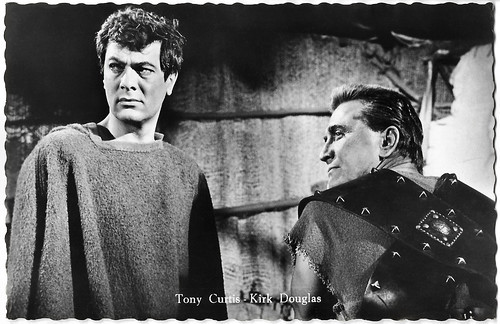
Dutch postcard, no. 1160. Photo: Universal International. Tony Curtis and Kirk Douglas in Spartacus (Stanley Kubrick, 1960).
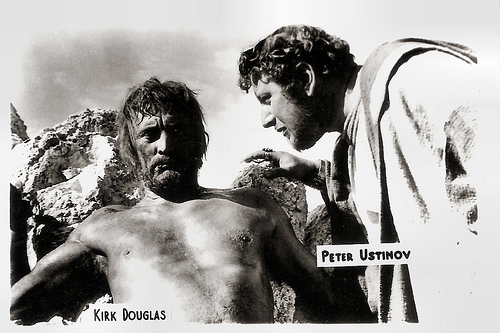
Romanian collectors card. Photo: publicity still for Spartacus (Stanley Kubrick, 1960) with Peter Ustinov.
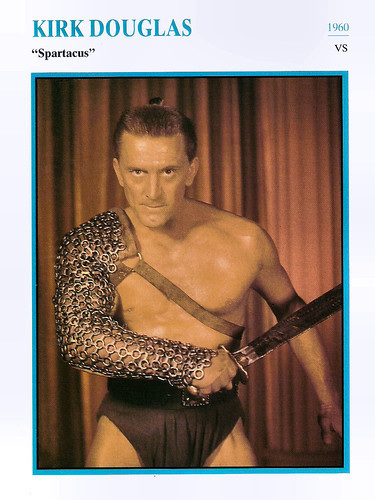
Dutch collectors card in the series 'Filmsterren: een Portret' by Edito Service, 1994. Photo: Collection Christophe L. Kirk Douglas in Spartacus (Stanley Kubrick, 1960)
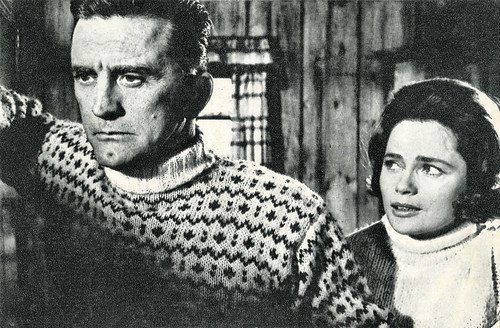
Romanian postcard by Casa Filmului Acin, no. 40. Kirk Douglas and Ulla Jacobsson in The Heroes of Telemark (Anthony Mann, 1965).

Italian postcard by Bromofoto, Milano, no. 1268. Photo: Paramount Films.
It Runs in the Family
Douglas remained busy throughout the 1960s, starring in many films. He produced and starred as a rebellious modern-day cowboy in Lonely Are the Brave (David Miller, 1962), considered a cult classic. He acted in the mystery The List of Adrian Messenger (John Huston, 1963), alongside John Wayne in the World War II story In Harm's Way (Otto Preminger, 1965), and in the tongue-in-cheek Western The War Wagon (Burt Kennedy, 1967).
On stage, he starred in 1963 in the Broadway production of Ken Kesey's One Flew Over The Cuckoo's Nest. He bought the film rights, but no Hollywood studio could be convinced to bring the story to the screen. Kirk's son Michael Douglas finally filmed the tale, One Flew Over The Cuckoo's Nest (Milos Forman, 1975), starring Jack Nicholson . The film won all five major Academy Awards (Best Picture, Actor in Lead Role, Actress in Lead Role, Director, and Screenplay).
Although Douglas wasn't as busy as previous years, he made nearly 40 films and appeared on various television shows between 1970 and 2008. In 1970, he starred in the Western There Was a Crooked Man... (Joseph L. Mankiewicz, 1970) alongside Henry Fonda. In 1973, he directed his first film, Scalawag. In 1978, he costarred with John Cassavetes and Amy Irving in the excellent horror film The Fury, directed by Brian De Palma. In 1980, he starred in The Final Countdown (Don Taylor, 1980), playing the commanding officer of the aircraft carrier USS Nimitz, which travels through time to the day before the 1941 attack on Pearl Harbor. It was produced by his son Peter Douglas.
His other films included the Western comedy The Villain (Hal Needham, 1979) with Arnold Schwarzenegger , the Sci-fi thriller Saturn 3 (Stanley Donen, 1980) and the Australian Western The Man from Snowy River (George Miller, 1982), which received a fair degree of critical acclaim and was the most popular Australian film of all time until Crocodile Dundee (Peter Faiman, 1986). In 1986, he also reunited with his longtime costar Burt Lancaster in the crime comedy Tough Guys (Jeff Kanew, 1986), with Eli Wallach. Less known are his roles in such European films as Un uomo da rispettare/The Master Touch (Michele Lupo, 1972) with Giuliano Gemma , and Veraz (Xavier Castano, 1991).
Douglas has long been involved in humanitarian causes and has been a Goodwill Ambassador for the US State Department since 1963. France honoured him with the Chevalier of the Legion of Honour. He was presented with a honorary Academy Award by Steven Spielberg in 1996. Despite a helicopter crash and a stroke suffered in the 1990s, Douglas focused on renewing his spiritual and religious life since. He underwent years of voice therapy and made the film Diamonds (John Mallory Asher, 1999), in which he played an old prizefighter who was recovering from a stroke. It costarred his longtime friend from his early years, Lauren Bacall.
Kirk Douglas was the last surviving superstar from the Golden Age of Hollywood. He lived with Belgium-born producer Anne Buydens, his wife of over 60 years. They had two children, television and film producer Peter Douglas (1955) and actor and stand-up comedian Eric Douglas. In 2004, Eric died of an accidental drug overdose at the age of 46. With his first wife, Bermudian actress Diana Dill, Kirk Douglas also has two children, Michael Douglas (1944) and Joel Douglas (1947). In 2003, Michael and Joel produced It Runs in the Family (Fred Schepisi, 2003), in which Kirk starred with Michael, Michael's son Cameron Douglas, and Diana Dill, playing his wife. His most recent film appearance was in a strong non-speaking role in Meurtres à l'Empire State Building (William Karel, 2008), a French tribute and doc-crime-drama celebrating American Film Noir and the icons of the Hollywood golden age.
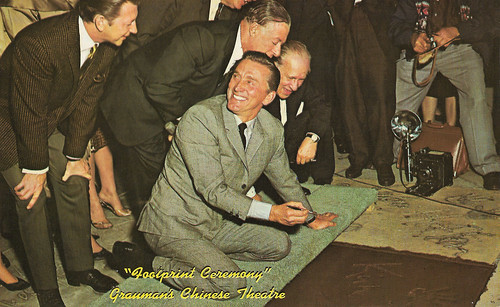
American postcard by Colourpicture, Boston, Mass., no. P51738. Caption: Grauman's Chinese Theatre, Hollywood, California. In the wet cement of the world famous forecourt, Mr. Kirk Douglas becomes a movie immortal as a crowd including Donald O'Connor and George Jessel looks on.
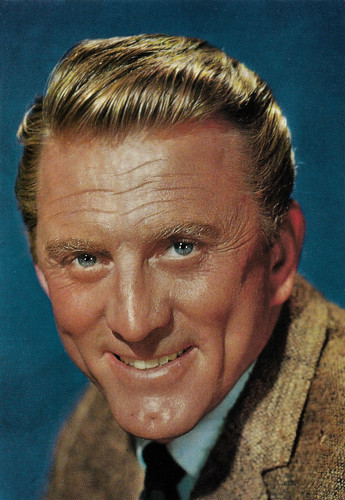
Spanish postcard by Postal Oscarcolor.
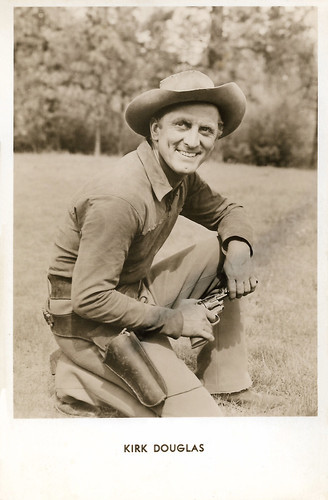
Belgian postcard, no. 5348.
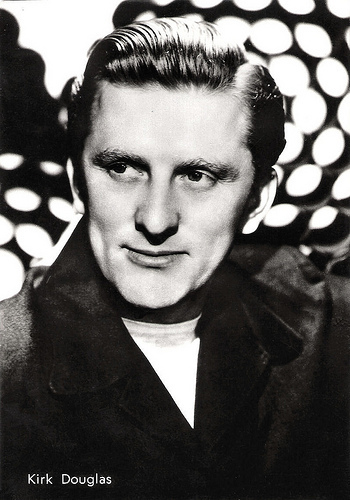
Italian postcard by Bromostampa, Milano, no. 55.
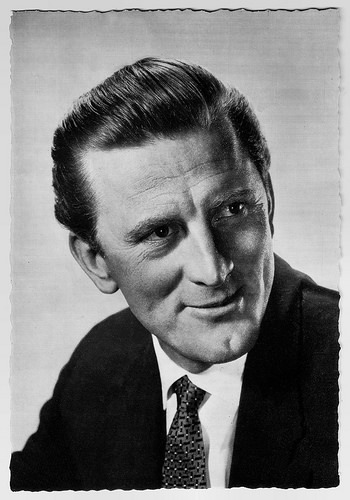
German postcard by WS-Druck, Wanne-Eickel, no. 253. Photo: Centfox.
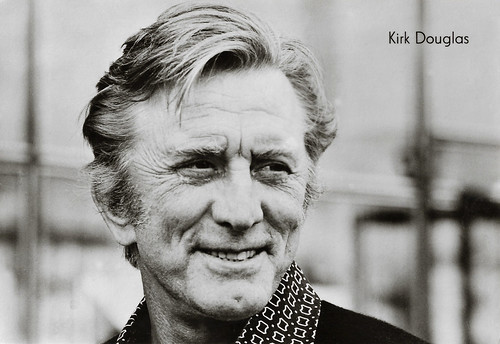
East-German postcard by Progress Film-Verleih, Berlin, no. 15/80. Photo: Günter Linke, 1979.
Trailer Ulysses (1954). Source: junkiefix (YouTube).
Trailer Spartacus (1960). Source: Movieclips Trailer Vault (YouTube).
Sources: (IMDb), (IMDb), Ella Alexander (The Independent), Wikipedia and .

Spanish postcard by Archivo Bermejo, no. 7143. Photo: Universal International, 1960. Kirk Douglas in Spartacus (Stanley Kubrick, 1960).

German postcard by ISV, no. A 42. Photo: 20th Century Fox. Publicity still for The Racers (Henry Hathaway, 1955).

French postcard in the Collection Cinema Couleur by Editions La Malibran, Paris/Nancy, 1989. Photo: John Bryson. Publicity still for Lust for Life (Vincente Minnelli, 1956).

Israelian postcard by Editions de Luxe. Photo: publicity still for The Last Sunset (Robert Aldrich, 1961).

Italian postcard by in the Artisti di Sempre series by Rotalfoto, Milano, no. 297.
The ragman's son
Kirk Douglas was born as 'the ragman's son' (the name of his 1988 autobiography) known as Issur Danielovitch Demsky, in Amsterdam, New York, in 1916. His parents, Bryna (Sanglel) and Herschel Danielovitch, were Jewish immigrants from Chavusy, Mahilyow Voblast (now in Belarus). Kirk had six sisters.
Growing up in a poor ghetto, 'Izzy' Demsky sold snacks to mill workers and delivered newspapers to earn enough to buy milk and bread to help his family. He was a fine student and wrestled competitively during his time at St. Lawrence University. He worked at more than forty different jobs before getting an acting job. The American Academy of Dramatic Arts gave him a special scholarship, but he only appeared in a handful of minor Broadway productions before joining the US Navy in 1941. He then legally changed his name to Kirk Douglas.
After the war, Douglas returned to New York City and found work in radio, theatre and commercials. His stage break occurred in Kiss and Tell, which led to other roles. On the insistence of ex-classmate Lauren Bacall producer Hal B. Wallis screen-tested Douglas and cast him opposite Barbara Stanwyck in The Strange Love of Martha Ivers (Lewis Milestone, 1946). He played a young, insecure man, stung with jealousy, whose life was dominated by a ruthless older woman, and he hid his feelings with alcohol. It would be the last time that Douglas portrayed a weakling in a film role.
His performance received rave reviews and further work quickly followed, including an appearance in the Film Noir I walk alone(Byron Haskin, 1948). It was the first time he worked alongside Burt Lancaster . They appeared in seven films together, including the dynamic western Gunfight at the O.K. Corral (John Sturges, 1957), the John Frankenheimer political thriller Seven Days in May (1964) and their final pairing in the gangster comedy Tough Guys (Jeff Kanew, 1986).

French postcard by Editions P.I., Paris, no. 393. Photo: Paramount Pictures Corporation.

Spanish postcard by Soberanas, no. 280. Photo: publicity still for Champion (Mark Robson, 1949) with Ruth Roman.

Dutch card. Photo: Warner Bros. Doris Day and Kirk Douglas in Young Man with a Horn (Michael Curtiz, 1950).

Spanish postcard by JDP, Valencia, no. 1375. Photo: Kirk Douglas and Eleanor Parker in Detective Story (William Wyler, 1951).

Belgian collectors card by De Beukelaer, Antwerp, no A 43. Photo: Warner Bros.
Vincent van Gogh
Douglas scored his first Oscar nomination playing the tough, unscrupulous boxing hero Midge Kelly in the gripping The Champion (Mark Robson, 1949). His acting style, relying on expressing great concentration, realism, and powerful emotions, made him a star. Among his early films were the musical drama Young Man with a Horn (Michael Curtiz, 1950) opposite Lauren Bacall, Billy Wilder's Film Noir on the press Ace in the Hole (1951) which won a best foreign film award at the Venice Film Festival, and the Film Noir Detective Story (William Wyler, 1951), nominated for four Academy Awards.
The quality of his work continued to garner the attention of critics. He was again nominated for an Oscar for his role as a film producer in The Bad and the Beautiful (Vincente Minnelli, 1952) opposite Lana Turner . Douglas plays a hard-nosed film producer who manipulates and uses his actors, writers, and directors. The film won five Academy Awards out of six nominations.
Douglas showed a lighter, comic touch in 20,000 Leagues Under the Sea (Richard Fleischer, 1954). In this adaptation of Jules Verne's 19th-century novel, he played a happy-go-lucky sailor who was the opposite in every way to the brooding Captain Nemo ( James Mason ). The film was one of Walt Disney's most successful live-action films, won two minor Oscars and was a major box-office hit.
He got another Oscar nomination for his portrayal of Dutch painter Vincent van Gogh in Lust for Life (Vincente Minnelli, 1956), based on Irving Stone's best-seller and filmed in France. Douglas was noted not only for the veracity of van Gogh's appearance but for how he conveyed the painter's massive creative power and his tortured soul. His moving and memorable Van Gogh is considered one of his finest roles. Douglas won a Golden Globe award.
Douglas demonstrated his independent streak and broke his contracts with Hal Wallis and Warner Brothers to gain total control over his projects. In Italy, he made the successful Ulisse/Ulyssus (Mario Camerini, 1954) an adaptation of Homer's second epic, that describes Ulysses' efforts to return to his home after the end of ten years of war. Douglas formed his own film company, Bryna Productions, named after his mother. The company was behind two pivotal film roles in his career. The first was as French army officer Colonel Dax in then relatively unknown director Stanley Kubrick's brilliant anti-war epic Paths of Glory (1957). During World War I, Dax tries to save three soldiers from the firing squad. While Paths of Glory did not do well at the box office, it has since become one of the great anti-war films.
Douglas reunited with Kubrick for yet another epic, the magnificent Spartacus (Stanley Kubrick, 1960). The film also marked a key turning point in the life of screenwriter Dalton Trumbo, who had been blacklisted during the McCarthy communist witch hunt in the 1950s. At Douglas' insistence Trumbo was given on-screen credit for his contributions. This began the dissolution of the infamous blacklisting policies begun almost a decade previously that had destroyed so many careers and lives. However, Trumbo's family later claimed that Douglas overstated his role.

Dutch postcard, no. 1160. Photo: Universal International. Tony Curtis and Kirk Douglas in Spartacus (Stanley Kubrick, 1960).

Romanian collectors card. Photo: publicity still for Spartacus (Stanley Kubrick, 1960) with Peter Ustinov.

Dutch collectors card in the series 'Filmsterren: een Portret' by Edito Service, 1994. Photo: Collection Christophe L. Kirk Douglas in Spartacus (Stanley Kubrick, 1960)

Romanian postcard by Casa Filmului Acin, no. 40. Kirk Douglas and Ulla Jacobsson in The Heroes of Telemark (Anthony Mann, 1965).

Italian postcard by Bromofoto, Milano, no. 1268. Photo: Paramount Films.
It Runs in the Family
Douglas remained busy throughout the 1960s, starring in many films. He produced and starred as a rebellious modern-day cowboy in Lonely Are the Brave (David Miller, 1962), considered a cult classic. He acted in the mystery The List of Adrian Messenger (John Huston, 1963), alongside John Wayne in the World War II story In Harm's Way (Otto Preminger, 1965), and in the tongue-in-cheek Western The War Wagon (Burt Kennedy, 1967).
On stage, he starred in 1963 in the Broadway production of Ken Kesey's One Flew Over The Cuckoo's Nest. He bought the film rights, but no Hollywood studio could be convinced to bring the story to the screen. Kirk's son Michael Douglas finally filmed the tale, One Flew Over The Cuckoo's Nest (Milos Forman, 1975), starring Jack Nicholson . The film won all five major Academy Awards (Best Picture, Actor in Lead Role, Actress in Lead Role, Director, and Screenplay).
Although Douglas wasn't as busy as previous years, he made nearly 40 films and appeared on various television shows between 1970 and 2008. In 1970, he starred in the Western There Was a Crooked Man... (Joseph L. Mankiewicz, 1970) alongside Henry Fonda. In 1973, he directed his first film, Scalawag. In 1978, he costarred with John Cassavetes and Amy Irving in the excellent horror film The Fury, directed by Brian De Palma. In 1980, he starred in The Final Countdown (Don Taylor, 1980), playing the commanding officer of the aircraft carrier USS Nimitz, which travels through time to the day before the 1941 attack on Pearl Harbor. It was produced by his son Peter Douglas.
His other films included the Western comedy The Villain (Hal Needham, 1979) with Arnold Schwarzenegger , the Sci-fi thriller Saturn 3 (Stanley Donen, 1980) and the Australian Western The Man from Snowy River (George Miller, 1982), which received a fair degree of critical acclaim and was the most popular Australian film of all time until Crocodile Dundee (Peter Faiman, 1986). In 1986, he also reunited with his longtime costar Burt Lancaster in the crime comedy Tough Guys (Jeff Kanew, 1986), with Eli Wallach. Less known are his roles in such European films as Un uomo da rispettare/The Master Touch (Michele Lupo, 1972) with Giuliano Gemma , and Veraz (Xavier Castano, 1991).
Douglas has long been involved in humanitarian causes and has been a Goodwill Ambassador for the US State Department since 1963. France honoured him with the Chevalier of the Legion of Honour. He was presented with a honorary Academy Award by Steven Spielberg in 1996. Despite a helicopter crash and a stroke suffered in the 1990s, Douglas focused on renewing his spiritual and religious life since. He underwent years of voice therapy and made the film Diamonds (John Mallory Asher, 1999), in which he played an old prizefighter who was recovering from a stroke. It costarred his longtime friend from his early years, Lauren Bacall.
Kirk Douglas was the last surviving superstar from the Golden Age of Hollywood. He lived with Belgium-born producer Anne Buydens, his wife of over 60 years. They had two children, television and film producer Peter Douglas (1955) and actor and stand-up comedian Eric Douglas. In 2004, Eric died of an accidental drug overdose at the age of 46. With his first wife, Bermudian actress Diana Dill, Kirk Douglas also has two children, Michael Douglas (1944) and Joel Douglas (1947). In 2003, Michael and Joel produced It Runs in the Family (Fred Schepisi, 2003), in which Kirk starred with Michael, Michael's son Cameron Douglas, and Diana Dill, playing his wife. His most recent film appearance was in a strong non-speaking role in Meurtres à l'Empire State Building (William Karel, 2008), a French tribute and doc-crime-drama celebrating American Film Noir and the icons of the Hollywood golden age.

American postcard by Colourpicture, Boston, Mass., no. P51738. Caption: Grauman's Chinese Theatre, Hollywood, California. In the wet cement of the world famous forecourt, Mr. Kirk Douglas becomes a movie immortal as a crowd including Donald O'Connor and George Jessel looks on.

Spanish postcard by Postal Oscarcolor.

Belgian postcard, no. 5348.

Italian postcard by Bromostampa, Milano, no. 55.

German postcard by WS-Druck, Wanne-Eickel, no. 253. Photo: Centfox.

East-German postcard by Progress Film-Verleih, Berlin, no. 15/80. Photo: Günter Linke, 1979.
Trailer Ulysses (1954). Source: junkiefix (YouTube).
Trailer Spartacus (1960). Source: Movieclips Trailer Vault (YouTube).
Sources: (IMDb), (IMDb), Ella Alexander (The Independent), Wikipedia and .
Published on February 06, 2020 22:00
February 5, 2020
Vanni Marcoux
Vanni Marcoux or Vanni-Marcoux (1877–1962) was a French operatic bass-baritone, renown as one of the most memorable singing-actors of the 20th century. Marcoux only acted in three silent films and one sound film, but these were significant leads.
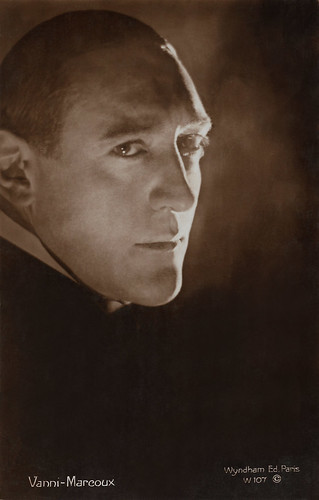
French postcard by Wyndham Ed., Paris, no. W 107. Vanni Marcoux' name was also written with a hyphen.
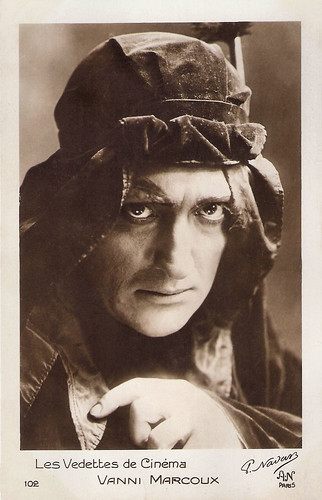
French postcard in the Les Vedettes de Cinéma series by A.N., Paris, no. 102. Photo: P. Nadar. Vanni Marcoux as Méphistophélès in Gounod’s 'Faust'? Or Vanni Marcoux in Le Miracle des Loups/Miracle of the Wolves (Raymond Bernard, 1924)? (The sources differ).
Vanni, short for Giovanni
Vanni Marcoux was born in 1877 in Turin, Italy, as Jean Emile Diogène Marcoux. He was born to a French father and an Italian mother. His mother gave him the nickname 'Vanni', short for Giovanni, the Italian equivalent of Jean.
He studied with Collini at the music conservatory in his hometown. He made his operatic debut in 1894, at the age of 17, as Sparafucile in Giuseppe Verdi's 'Rigoletto', in Turin.
After further studies in Paris with Frédéric Boyer, he made his first stage appearance in France, at Bayonne, as Frère Laurent in Charles Gounod's 'Roméo et Juliette', in 1899.
Marcoux became particularly associated with the French and Italian repertories. He made his Paris Opéra debut in 1908 as Méphisto in Gounod's 'Faust', and at La Scala in 1910, as the Old Hebrew in Camille Saint-Saëns' 'Samson and Delilah'.
The same year, 1910, he sang for the first time Jules Massenet's 'Don Quichotte' at the Gaieté Lyrique in Paris, a part that would soon become his signature role. His huge repertoire included an estimated 240 roles and he won renown as one of the most memorable singing-actors of the 20th century. He married Madeleine Morlay, an actress, in 1914.
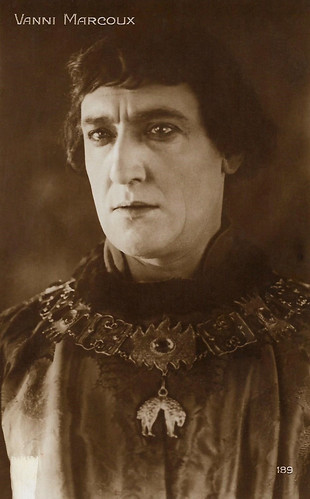
French postcard by Cinémagazine-Edition, no. 189. Vanni Marcoux as Charles le Téméraire in the French silent film Le Miracle des Loups/Miracle of the Wolves (Raymond Bernard, 1924).
The remarkably wide variety of operatic roles
Vanni Marcoux only acted in 3 silent films and one sound film, but these were significant leads. He appeared as Faust in Don Juan et Faust/Don Juan and Faust (Marcel L'Herbier, 1922) opposite Jaque Catelain as Don Juan, and as Maurice Ferrioul in the Franco-British coproduction The Scandal (Arthur Rooke, 1923).
His best known role is probably as Charles le Téméraire (Charles the Bold) in Le Miracle des Loups/Miracle of the Wolves (Raymond Bernard, 1924) with Charles Dullin and Yvonne Sergyl. He later also appeared as Vitalis in the sound film Sans famille/Without family (Marc Allégret, 1934) with Robert Lynen as Rémy.
Vanni Marcoux began teaching at the Paris Conservatory in 1938. He retired from the stage in 1948 and became director of the Grand Théâtre de Bordeaux. He held that post from 1948 to 1951.
Wikipedia : "Vanni Marcoux's career was impressive for its longevity and the remarkably wide variety of operatic roles which it embraced. He possessed a clear, although not especially large voice, with a characteristic vibrato and a weight and timbre of almost tenor quality."
Vanni Marcoux died in 1962 in Paris, France.
Short videotaped scene from Sans famille/Without family (1934). Source: Alexis Goussev (YouTube).
Scene from Sans famille/Without family (1934). Source: Vieux Disques (YouTube).
Sources: Wikipedia and .

French postcard by Wyndham Ed., Paris, no. W 107. Vanni Marcoux' name was also written with a hyphen.

French postcard in the Les Vedettes de Cinéma series by A.N., Paris, no. 102. Photo: P. Nadar. Vanni Marcoux as Méphistophélès in Gounod’s 'Faust'? Or Vanni Marcoux in Le Miracle des Loups/Miracle of the Wolves (Raymond Bernard, 1924)? (The sources differ).
Vanni, short for Giovanni
Vanni Marcoux was born in 1877 in Turin, Italy, as Jean Emile Diogène Marcoux. He was born to a French father and an Italian mother. His mother gave him the nickname 'Vanni', short for Giovanni, the Italian equivalent of Jean.
He studied with Collini at the music conservatory in his hometown. He made his operatic debut in 1894, at the age of 17, as Sparafucile in Giuseppe Verdi's 'Rigoletto', in Turin.
After further studies in Paris with Frédéric Boyer, he made his first stage appearance in France, at Bayonne, as Frère Laurent in Charles Gounod's 'Roméo et Juliette', in 1899.
Marcoux became particularly associated with the French and Italian repertories. He made his Paris Opéra debut in 1908 as Méphisto in Gounod's 'Faust', and at La Scala in 1910, as the Old Hebrew in Camille Saint-Saëns' 'Samson and Delilah'.
The same year, 1910, he sang for the first time Jules Massenet's 'Don Quichotte' at the Gaieté Lyrique in Paris, a part that would soon become his signature role. His huge repertoire included an estimated 240 roles and he won renown as one of the most memorable singing-actors of the 20th century. He married Madeleine Morlay, an actress, in 1914.

French postcard by Cinémagazine-Edition, no. 189. Vanni Marcoux as Charles le Téméraire in the French silent film Le Miracle des Loups/Miracle of the Wolves (Raymond Bernard, 1924).
The remarkably wide variety of operatic roles
Vanni Marcoux only acted in 3 silent films and one sound film, but these were significant leads. He appeared as Faust in Don Juan et Faust/Don Juan and Faust (Marcel L'Herbier, 1922) opposite Jaque Catelain as Don Juan, and as Maurice Ferrioul in the Franco-British coproduction The Scandal (Arthur Rooke, 1923).
His best known role is probably as Charles le Téméraire (Charles the Bold) in Le Miracle des Loups/Miracle of the Wolves (Raymond Bernard, 1924) with Charles Dullin and Yvonne Sergyl. He later also appeared as Vitalis in the sound film Sans famille/Without family (Marc Allégret, 1934) with Robert Lynen as Rémy.
Vanni Marcoux began teaching at the Paris Conservatory in 1938. He retired from the stage in 1948 and became director of the Grand Théâtre de Bordeaux. He held that post from 1948 to 1951.
Wikipedia : "Vanni Marcoux's career was impressive for its longevity and the remarkably wide variety of operatic roles which it embraced. He possessed a clear, although not especially large voice, with a characteristic vibrato and a weight and timbre of almost tenor quality."
Vanni Marcoux died in 1962 in Paris, France.
Short videotaped scene from Sans famille/Without family (1934). Source: Alexis Goussev (YouTube).
Scene from Sans famille/Without family (1934). Source: Vieux Disques (YouTube).
Sources: Wikipedia and .
Published on February 05, 2020 22:00
February 4, 2020
Lissi Arna
Lissi Arna (1900-1964) was a beautiful, exotic-looking German silent screen actress. She became a star opposite the popular action star Harry Piel, and had a brief Hollywood career. Usually she was cast as a femme fatale or a fallen woman.
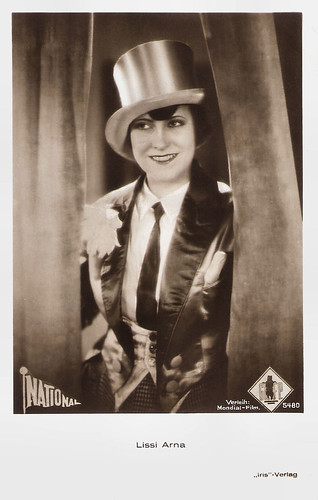
Austrian postcard by Iris-Verlag, no. 5480. Photo: Mondial-Film / GFP / National.
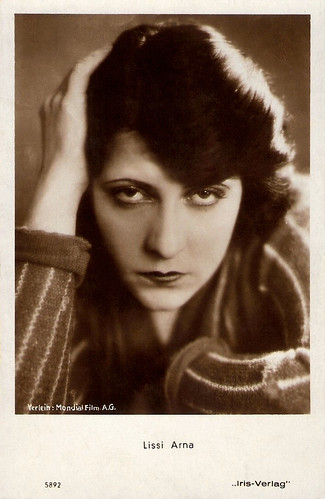
Austrian postcard by Iris-Verlag, no. 5892. Photo: Mondial Film A.G.
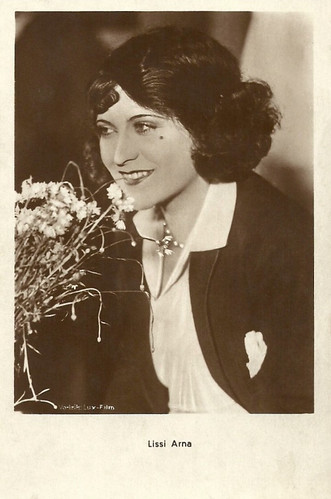
Austrian postcard. Photo: Lux-Film.
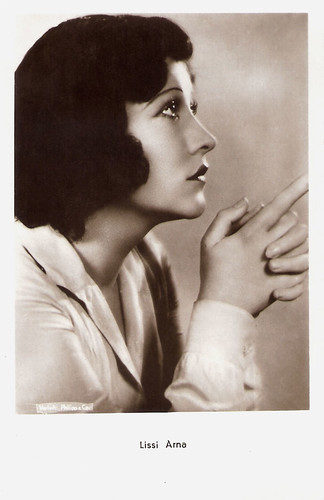
Austrian postcard by Iris Verlag, no. 6134; distributed in Italy by Casa Editrice Ballerini & Fratini, Firenze. Photo: Verleih Philipp & Co.
Dark-skinned Exotic Beauty
Lissi Arna (or Lissy Arna) was born as Elisabeth Arndt in Berlin in 1904. She attended a trade school and then started to work for a house broker.
Meanwhile she also appeared as an extra in silent shorts like Der Katzensteg/The Cat's Gang Plank (Max Mack, 1915) before she was engaged by comedian Ottchen Mücke as partner for his series of short films, directed by Rudi Bach.
The public liked her and she even got her own short, Lissys Flimmerkur/Lissy's Short Flicker (Rudi Bach, 1919). Her first real feature film was Abenteuer einer Nacht/Night's Adventures (1923), directed and produced by action star Harry Piel .
The next two years she lived with relatives in New York and her film career was interrupted. When she returned it was again Harry Piel who offered her the female lead in his film Abenteuer im Nachtexpress/Adventures in the Night Express (1925, Harry Piel). This film paved the way for a great career.
She played in dozens of silent crime films, comedies and farces during the following years. Das Frauenhaus von Rio/The Women House of Rio (Hans Steinhoff, 1927) starring Vivian Gibson moulded her image as a dark-skinned exotic beauty definitely.
She used her femme fatale charisma successfully in films like Die Elf Teufel/The Eleven Devils (Zoltan Korda, Carl Boese, 1927) with Gustav Fröhlich , Schinderhannes/The Prince of Rogues (Kurt (later: Curtis) Bernhardt, 1928) featuring Hans Stüwe , the British production The Physician (Georg Jacoby, 1928) and as a proletarian prostitute in Jenseits der Straße/Beyond the Street (Leo Mittler, 1929), which Ines Walk at the now obsolete website Filmzeit.de mentioned as her most memorable role.
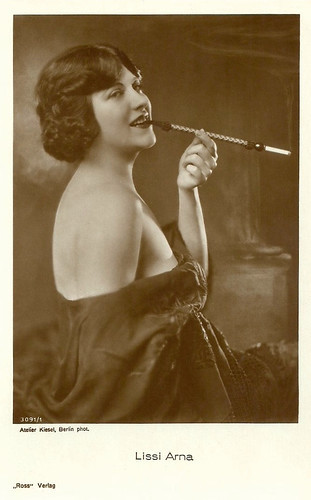
German postcard by Ross Verlag, no. 3091/1, 1928-1929. Photo: Atelier Kiesel, Berlin.
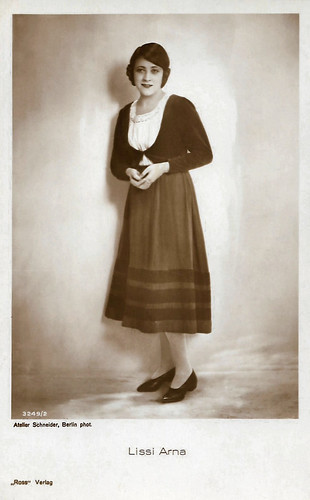
German postcard by Ross Verlag, no. 3249/2, 1928-1929. Photo: Atelier Scheider, Berlin.
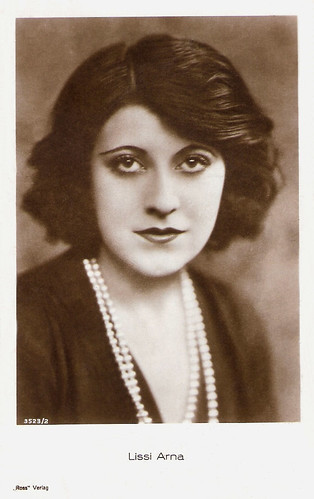
German postcard by Ross Verlag, no. 3523/2, 1928-1929.
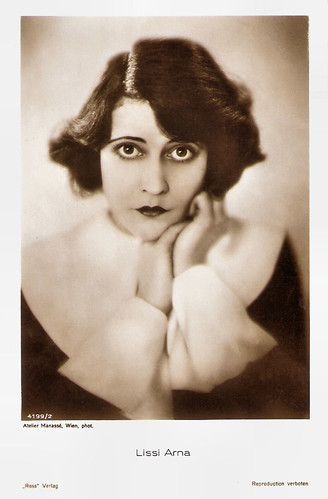
German postcard by Ross Verlag, no. 4199/2, 1929-1930. Photo: Atelier Manassé, Wien.
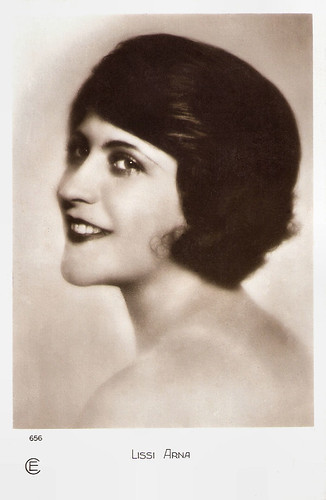
French postcard by Cinémagazine-Edition, Paris, no. 656.
The Newest European Import
In 1930 Lissi Arna went to Hollywood, together with director Wilhelm Dieterle (later William Dieterle). Highly publicised as the newest European import.
She was contracted by RKO and played William Boyd's German fiancee in the World War I melodrama Beyond Victory (John S. Robertson, 1931). The film was an obvious attempt at duplicating the success of Universal's antiwar statement All Quiet on the Western Front (Lewis Milestone, 1930) but fell far short of such lofty expectations and did little for her. Apparently her role was severely cut prior to release.
In Hollywood, she went on to play in several German-language versions of American pictures like Die Maske fällt/The Costume Falls (William Dieterle, 1930) and Dämon des Meeres/Demon of the Sea (Michael Curtiz, 1930).
In 1931 she returned to Germany and achieved her last great successes with the Edgar Wallace adaptation Der Zinker/The Squeeker (Martin Fric, Carl Lamac, 1931) with Karl Ludwig Diehl , and the mountain drama Berge in Flammen/Mountains on Fire (Karl Hartl, Luis Trenker, 1931).
The arrival of sound film obviously had hurt her career. She moved over to work in the theatres of Berlin. Her further film works were confined to supporting roles in films like Zu neuen Ufern/To New Shores (Douglas Sirk, 1937) starring Zarah Leander .
Lissi married the physician Dr. Kleiber in 1939 and then retired completely from the film business. She lived with her husband in Venezuela till his death in the late 1950s. She returned to Germany, and in 1962 she played for the last time in a film, Das Leben beginnt um acht/Life Starts at Eight (Michael Kehlmann, 1962) with O.E. Hasse .
In 1964, Lissi Arna died of cancer in her hometown, Berlin. She was 63. Arna was interred at the Kaiser-Wilhelm-Gedächtnis-Friedhof in Westend. Wikipedia notes that her grave has not been preserved.

French postcard by Editions Cinémagazine, no. 684.
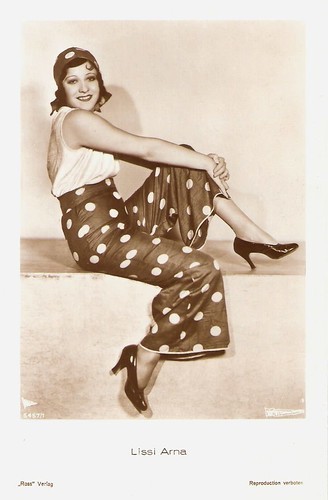
German postcard by Ross Verlag, no. 5457/1, 1930-1931. Photo: Vitaphone.
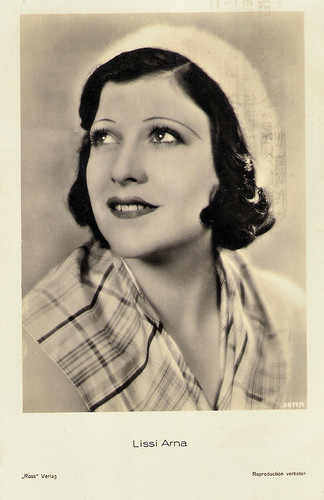
German postcard by Ross Verlag, no. 5917/1, 1930-1931. Sent by mail in the Netherlands in 1931.
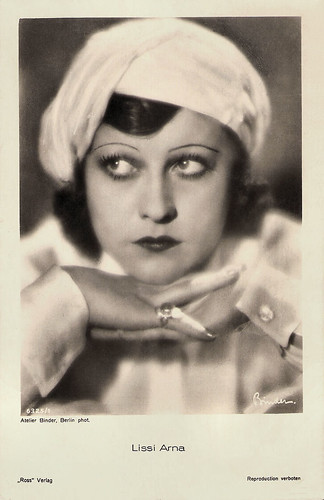
German postcard by Ross Verlag, no. 6325/1, 1931-1932. Photo: Atelier Binder, Berlin.
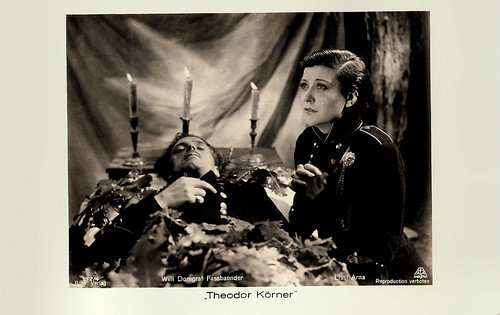
German postcard by Ross Verlag, no. 152/4, 1932. Photo: Aafa Film. Lissi Arna and Willi Domgraf-Fassbaender in Theodor Körner (Carl Boese, 1932).
Sources: Ines Walk (Filmzeit.de; now obsolete), Thomas Staedeli (Cyranos), Hans J. Wollstein (AllMovie), Wikipedia (German) and .

Austrian postcard by Iris-Verlag, no. 5480. Photo: Mondial-Film / GFP / National.

Austrian postcard by Iris-Verlag, no. 5892. Photo: Mondial Film A.G.

Austrian postcard. Photo: Lux-Film.

Austrian postcard by Iris Verlag, no. 6134; distributed in Italy by Casa Editrice Ballerini & Fratini, Firenze. Photo: Verleih Philipp & Co.
Dark-skinned Exotic Beauty
Lissi Arna (or Lissy Arna) was born as Elisabeth Arndt in Berlin in 1904. She attended a trade school and then started to work for a house broker.
Meanwhile she also appeared as an extra in silent shorts like Der Katzensteg/The Cat's Gang Plank (Max Mack, 1915) before she was engaged by comedian Ottchen Mücke as partner for his series of short films, directed by Rudi Bach.
The public liked her and she even got her own short, Lissys Flimmerkur/Lissy's Short Flicker (Rudi Bach, 1919). Her first real feature film was Abenteuer einer Nacht/Night's Adventures (1923), directed and produced by action star Harry Piel .
The next two years she lived with relatives in New York and her film career was interrupted. When she returned it was again Harry Piel who offered her the female lead in his film Abenteuer im Nachtexpress/Adventures in the Night Express (1925, Harry Piel). This film paved the way for a great career.
She played in dozens of silent crime films, comedies and farces during the following years. Das Frauenhaus von Rio/The Women House of Rio (Hans Steinhoff, 1927) starring Vivian Gibson moulded her image as a dark-skinned exotic beauty definitely.
She used her femme fatale charisma successfully in films like Die Elf Teufel/The Eleven Devils (Zoltan Korda, Carl Boese, 1927) with Gustav Fröhlich , Schinderhannes/The Prince of Rogues (Kurt (later: Curtis) Bernhardt, 1928) featuring Hans Stüwe , the British production The Physician (Georg Jacoby, 1928) and as a proletarian prostitute in Jenseits der Straße/Beyond the Street (Leo Mittler, 1929), which Ines Walk at the now obsolete website Filmzeit.de mentioned as her most memorable role.

German postcard by Ross Verlag, no. 3091/1, 1928-1929. Photo: Atelier Kiesel, Berlin.

German postcard by Ross Verlag, no. 3249/2, 1928-1929. Photo: Atelier Scheider, Berlin.

German postcard by Ross Verlag, no. 3523/2, 1928-1929.

German postcard by Ross Verlag, no. 4199/2, 1929-1930. Photo: Atelier Manassé, Wien.

French postcard by Cinémagazine-Edition, Paris, no. 656.
The Newest European Import
In 1930 Lissi Arna went to Hollywood, together with director Wilhelm Dieterle (later William Dieterle). Highly publicised as the newest European import.
She was contracted by RKO and played William Boyd's German fiancee in the World War I melodrama Beyond Victory (John S. Robertson, 1931). The film was an obvious attempt at duplicating the success of Universal's antiwar statement All Quiet on the Western Front (Lewis Milestone, 1930) but fell far short of such lofty expectations and did little for her. Apparently her role was severely cut prior to release.
In Hollywood, she went on to play in several German-language versions of American pictures like Die Maske fällt/The Costume Falls (William Dieterle, 1930) and Dämon des Meeres/Demon of the Sea (Michael Curtiz, 1930).
In 1931 she returned to Germany and achieved her last great successes with the Edgar Wallace adaptation Der Zinker/The Squeeker (Martin Fric, Carl Lamac, 1931) with Karl Ludwig Diehl , and the mountain drama Berge in Flammen/Mountains on Fire (Karl Hartl, Luis Trenker, 1931).
The arrival of sound film obviously had hurt her career. She moved over to work in the theatres of Berlin. Her further film works were confined to supporting roles in films like Zu neuen Ufern/To New Shores (Douglas Sirk, 1937) starring Zarah Leander .
Lissi married the physician Dr. Kleiber in 1939 and then retired completely from the film business. She lived with her husband in Venezuela till his death in the late 1950s. She returned to Germany, and in 1962 she played for the last time in a film, Das Leben beginnt um acht/Life Starts at Eight (Michael Kehlmann, 1962) with O.E. Hasse .
In 1964, Lissi Arna died of cancer in her hometown, Berlin. She was 63. Arna was interred at the Kaiser-Wilhelm-Gedächtnis-Friedhof in Westend. Wikipedia notes that her grave has not been preserved.

French postcard by Editions Cinémagazine, no. 684.

German postcard by Ross Verlag, no. 5457/1, 1930-1931. Photo: Vitaphone.

German postcard by Ross Verlag, no. 5917/1, 1930-1931. Sent by mail in the Netherlands in 1931.

German postcard by Ross Verlag, no. 6325/1, 1931-1932. Photo: Atelier Binder, Berlin.

German postcard by Ross Verlag, no. 152/4, 1932. Photo: Aafa Film. Lissi Arna and Willi Domgraf-Fassbaender in Theodor Körner (Carl Boese, 1932).
Sources: Ines Walk (Filmzeit.de; now obsolete), Thomas Staedeli (Cyranos), Hans J. Wollstein (AllMovie), Wikipedia (German) and .
Published on February 04, 2020 22:00
February 3, 2020
Lorena (1918)
Last week, you could read a post here on the French silent film Midinettes (René Hervil, Louis Mercanton, 1917), starring one of our favourite European film stars, Suzanne Grandais. Today another post on a film with Grandais, Lorena (Georges Tréville, 1918), produced by Eclair. The Spanish company Amatller Marca Luna published the cards to promote their chocolates.
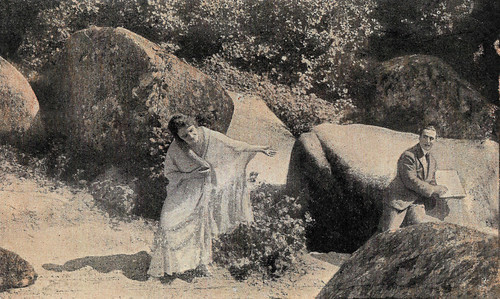
Spanish collectors card by Amatller Marca Luna, series 6, no. 1. Photo: Eclipse. Suzanne Grandais and Fred Zorilla in Lorena (Georges Tréville, 1918).
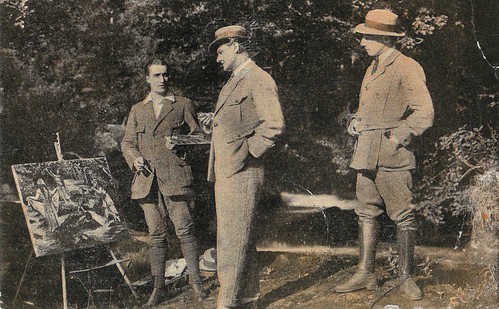
Spanish collectors card by Amattler Marca Luna chocolate, series 6, no. 2. Photo: Eclipse. Fred Zorilla and Jean Ayme in Lorena (Georges Tréville, 1918).
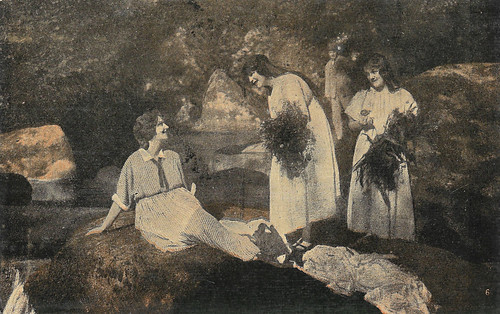
Spanish collectors card by Amatller Marca Luna, series 6, no. 3. Photo: Eclipse. Suzanne Grandais in Lorena (Georges Tréville, 1918).
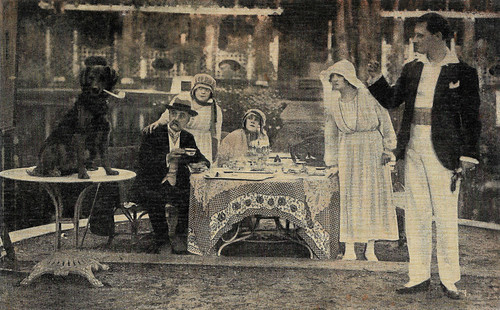
Spanish collectors card by Amatller Marca Luna, series 6, no. 4. Photo: Eclipse. Suzanne Grandais , Jean Ayme and Maillard in Lorena (Georges Tréville, 1918).
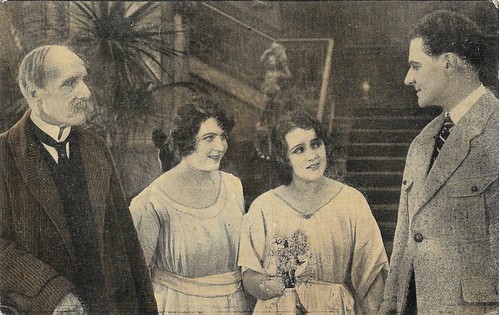
Spanish collectors card by Amatller Marca Luna, series 6, no. 5. Photo: Eclipse. Maillard, Suzanne Grandais (right woman) and Jean Ayme in Lorena (Georges Tréville, 1918).
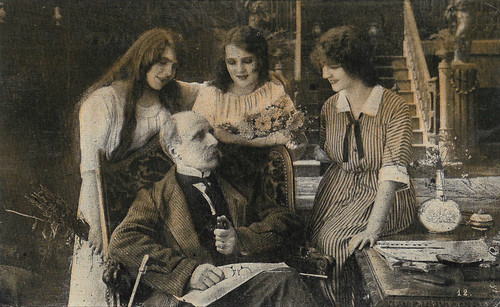
Spanish collectors card b Amattler Marca Luna chocolate, series 6, no. 6. Photo: Eclipse. On the right, Suzanne Grandais and Maillard in Lorena (Georges Tréville, 1918).
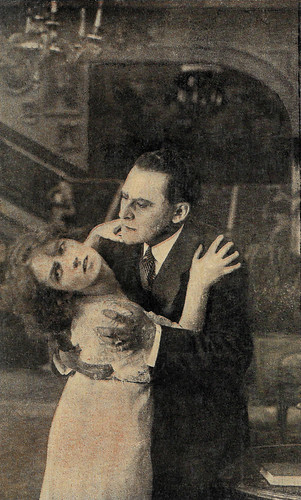
Spanish collectors card by Amatller Marca Luna, series 6, no. 7. Photo: Eclipse. Suzanne Grandais and Jean Ayme in Lorena (Georges Tréville, 1918).
Our search for the plot
It was hard to find the plot of Lorena (Georges Tréville, 1918) on French sites. In the French online system Gallica e.g. some numbers of the leading magazine Ciné-Journal from 1918 are failing. Thanks to the Dutch online newspaper site Delpher, we managed to find a content description in the Provinciale Geldersche en Nijmeegsche courant, a Dutch regional paper of 1919.
Lorena is the daughter of the marquis of Chambrey, and secretly engaged to the painter Pierre Laurent, but her father has other plans. He wants to give her hand to Count Borgo, a son of a late friend.
Lorena hides in Mme Laurent's place but is discovered and brought back home. yet, when it all comes out that Count Borgo is already married, Lorena may marry her artist. Borgo, though, is keen on revenge and challenges Pierre to a duel.
When the duel is undecided, Pierre comes into his power. When Borgo wants to use his right to shoot at Pierre from a distance of 12 meters, Lorena intervenes. After having drugged her lover, she dresses like a man and goes to the duel. Borgo is softened by so much courage and shoots at a bottle instead of at the woman.
Lorena was produced by Grandais' own company Les Films Suzanne Grandais, but under the aegis of Eclipse, and also distributed by Eclipse. Scriptwriter was Claude Valmont.
The main actors were Suzanne Grandais in the title role, Jean Ayme as Count Borgo and Fred Zorilla as Pierre Laurent. Supporting actors were Berthe Jalabert as Madame Laurent and Maillard as Monsieur Chambrey. The film premiered in Paris on 11 February 1918 (so a year before the review in the Dutch regional paper).
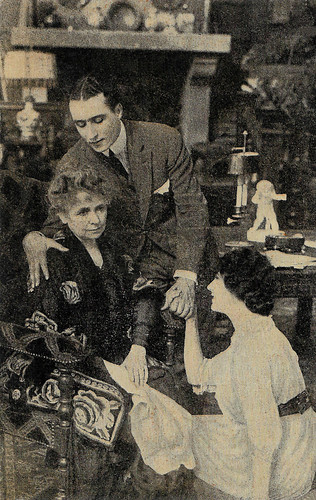
Spanish collectors card by Amatller Marca Luna, series 6, no. 8. Photo: Eclipse. Suzanne Grandais , Fred Zorilla and Berthe Jalabert in Lorena (Georges Tréville, 1918).
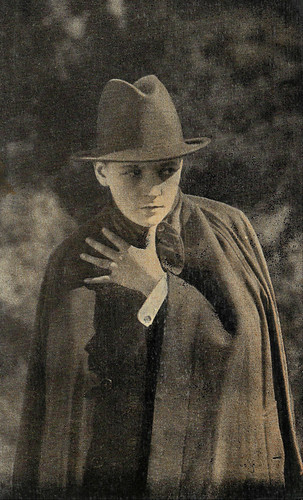
Spanish collectors card by Amattler Marca Luna chocolate, series 6, no. 9. Photo: Eclipse. Suzanne Grandais in Lorena (Georges Tréville, 1918).
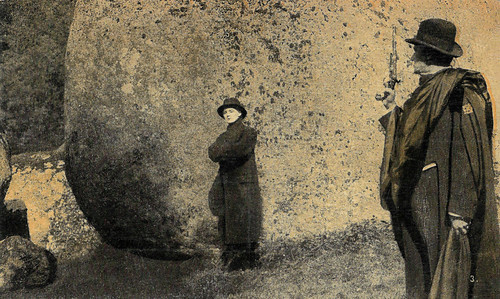
Spanish collectors card by Amatller Marca Luna, series 6, no. 10. Photo: Eclipse. Suzanne Grandais and Jean Ayme in Lorena (Georges Tréville, 1918).
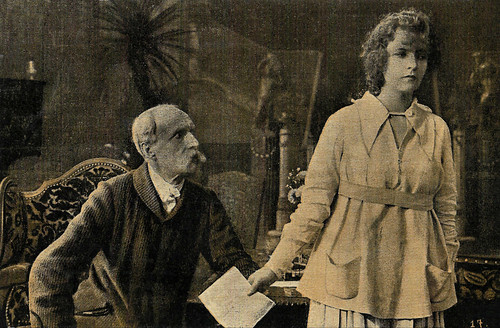
Spanish collectors card by Amattler Marca Luna, series 6, no. 11. Photo: Eclair. Suzanne Grandais and Maillard in Lorena (Georges Tréville, 1918).
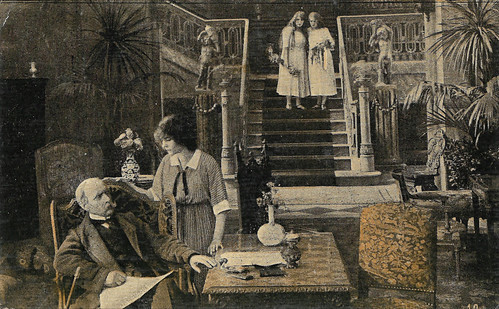
Spanish collectors card by Amattler Marca Luna, series 6, no. 12. Photo: Eclair. Suzanne Grandais and Maillard in Lorena (Georges Tréville, 1918).
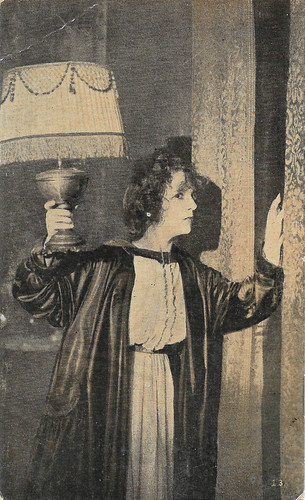
Spanish collectors card by Amatller Marca Luna, series 6, no. 13. Photo: Eclipse. Suzanne Grandais in Lorena (Georges Tréville, 1918).
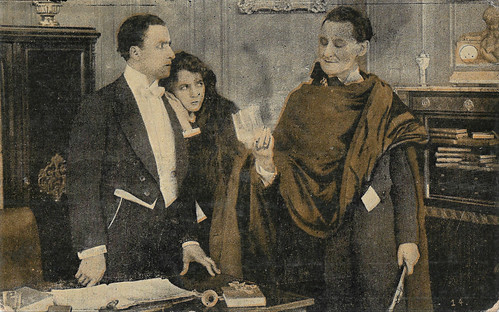
Spanish collectors card by Amatller Marca Luna, series 6, no. 14. Photo: Eclipse. Fred Zorilla, Suzanne Grandais and Jean Ayme in Lorena (Georges Tréville, 1918).
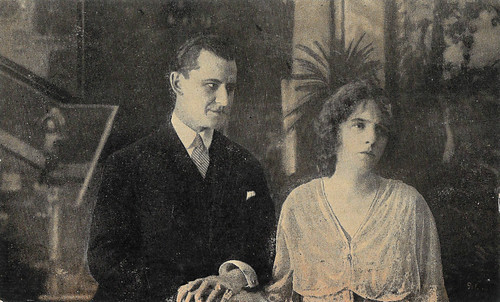
Spanish collectors card by Amatller Marca Luna, series 6, no. 15. Photo: Eclipse. Jean Ayme and Suzanne Grandais in Lorena (Georges Tréville, 1918).
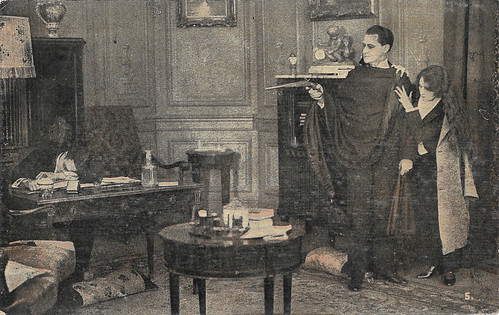
Spanish collectors card by Amatller Marca Luna, series 6, no. 17. Photo: Eclipse. Fred Zorilla, Suzanne Grandais , and Jean Ayme in Lorena (Georges Tréville, 1918).
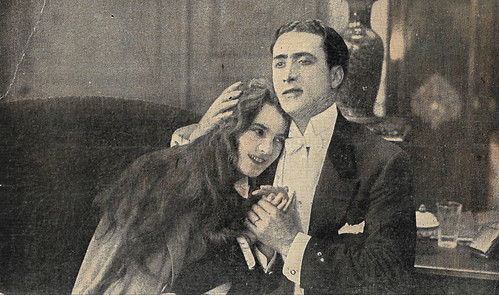
Spanish collectors card by Amatller Marca Luna, series 6, no. 18. Photo: Eclipse. Suzanne Grandais and Fred Zorilla in Lorena (Georges Tréville, 1918).
Sources: Provinciale Geldersche en Nijmeegsche courant, 15-02-1919 (Delpher - Dutch), Wikipedia and IMDb.

Spanish collectors card by Amatller Marca Luna, series 6, no. 1. Photo: Eclipse. Suzanne Grandais and Fred Zorilla in Lorena (Georges Tréville, 1918).

Spanish collectors card by Amattler Marca Luna chocolate, series 6, no. 2. Photo: Eclipse. Fred Zorilla and Jean Ayme in Lorena (Georges Tréville, 1918).

Spanish collectors card by Amatller Marca Luna, series 6, no. 3. Photo: Eclipse. Suzanne Grandais in Lorena (Georges Tréville, 1918).

Spanish collectors card by Amatller Marca Luna, series 6, no. 4. Photo: Eclipse. Suzanne Grandais , Jean Ayme and Maillard in Lorena (Georges Tréville, 1918).

Spanish collectors card by Amatller Marca Luna, series 6, no. 5. Photo: Eclipse. Maillard, Suzanne Grandais (right woman) and Jean Ayme in Lorena (Georges Tréville, 1918).

Spanish collectors card b Amattler Marca Luna chocolate, series 6, no. 6. Photo: Eclipse. On the right, Suzanne Grandais and Maillard in Lorena (Georges Tréville, 1918).

Spanish collectors card by Amatller Marca Luna, series 6, no. 7. Photo: Eclipse. Suzanne Grandais and Jean Ayme in Lorena (Georges Tréville, 1918).
Our search for the plot
It was hard to find the plot of Lorena (Georges Tréville, 1918) on French sites. In the French online system Gallica e.g. some numbers of the leading magazine Ciné-Journal from 1918 are failing. Thanks to the Dutch online newspaper site Delpher, we managed to find a content description in the Provinciale Geldersche en Nijmeegsche courant, a Dutch regional paper of 1919.
Lorena is the daughter of the marquis of Chambrey, and secretly engaged to the painter Pierre Laurent, but her father has other plans. He wants to give her hand to Count Borgo, a son of a late friend.
Lorena hides in Mme Laurent's place but is discovered and brought back home. yet, when it all comes out that Count Borgo is already married, Lorena may marry her artist. Borgo, though, is keen on revenge and challenges Pierre to a duel.
When the duel is undecided, Pierre comes into his power. When Borgo wants to use his right to shoot at Pierre from a distance of 12 meters, Lorena intervenes. After having drugged her lover, she dresses like a man and goes to the duel. Borgo is softened by so much courage and shoots at a bottle instead of at the woman.
Lorena was produced by Grandais' own company Les Films Suzanne Grandais, but under the aegis of Eclipse, and also distributed by Eclipse. Scriptwriter was Claude Valmont.
The main actors were Suzanne Grandais in the title role, Jean Ayme as Count Borgo and Fred Zorilla as Pierre Laurent. Supporting actors were Berthe Jalabert as Madame Laurent and Maillard as Monsieur Chambrey. The film premiered in Paris on 11 February 1918 (so a year before the review in the Dutch regional paper).

Spanish collectors card by Amatller Marca Luna, series 6, no. 8. Photo: Eclipse. Suzanne Grandais , Fred Zorilla and Berthe Jalabert in Lorena (Georges Tréville, 1918).

Spanish collectors card by Amattler Marca Luna chocolate, series 6, no. 9. Photo: Eclipse. Suzanne Grandais in Lorena (Georges Tréville, 1918).

Spanish collectors card by Amatller Marca Luna, series 6, no. 10. Photo: Eclipse. Suzanne Grandais and Jean Ayme in Lorena (Georges Tréville, 1918).

Spanish collectors card by Amattler Marca Luna, series 6, no. 11. Photo: Eclair. Suzanne Grandais and Maillard in Lorena (Georges Tréville, 1918).

Spanish collectors card by Amattler Marca Luna, series 6, no. 12. Photo: Eclair. Suzanne Grandais and Maillard in Lorena (Georges Tréville, 1918).

Spanish collectors card by Amatller Marca Luna, series 6, no. 13. Photo: Eclipse. Suzanne Grandais in Lorena (Georges Tréville, 1918).

Spanish collectors card by Amatller Marca Luna, series 6, no. 14. Photo: Eclipse. Fred Zorilla, Suzanne Grandais and Jean Ayme in Lorena (Georges Tréville, 1918).

Spanish collectors card by Amatller Marca Luna, series 6, no. 15. Photo: Eclipse. Jean Ayme and Suzanne Grandais in Lorena (Georges Tréville, 1918).

Spanish collectors card by Amatller Marca Luna, series 6, no. 17. Photo: Eclipse. Fred Zorilla, Suzanne Grandais , and Jean Ayme in Lorena (Georges Tréville, 1918).

Spanish collectors card by Amatller Marca Luna, series 6, no. 18. Photo: Eclipse. Suzanne Grandais and Fred Zorilla in Lorena (Georges Tréville, 1918).
Sources: Provinciale Geldersche en Nijmeegsche courant, 15-02-1919 (Delpher - Dutch), Wikipedia and IMDb.
Published on February 03, 2020 22:00
February 2, 2020
Heidemarie Wenzel
German actress Heidemarie Wenzel (1945) became known in DEFA films of the early 1970s, such as Zeit der Störche/Time of the storks (1971) and Nemuritorii (1974). After her move to West-Germany, she became a star in both West and East Germany in the TV series Unsere Hagenbecks/Our Hagenbecks (1991-1994).
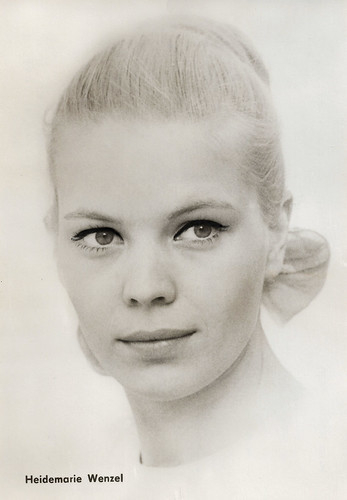
East-German postcard by VEB Progress Film-Vertrieb, Berlin, no. 3302, 1968, 1971. Retail price: M 0,20. Photo: Schwarz.
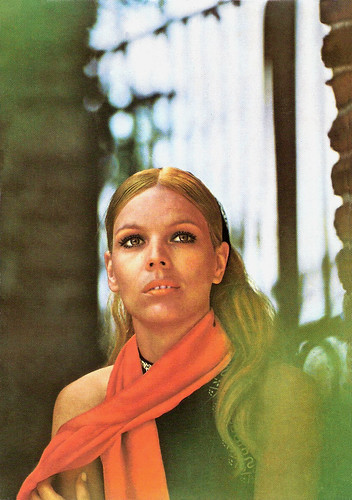
East-German postcard by VEB Progress Film-Vertrieb, Berlin / VEB Bild und Heimat Reichenbach, no. 5/F/73, 1973. Retail price: 0,20 M. Photo: Uhlenhut.
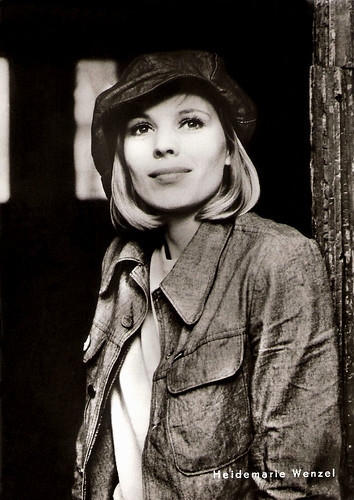
East-German postcard by VEB Progress Film-Vertrieb, Berlin, no. 87/75, 1975. Retail price: 0,20 M. Photo: Uhlenhut.
Open-minded and intelligent as well as introverted
Heidemarie Wenzel was born in 1945 in Berlin, Germany. During her youth, she played in the children's theatre and in the movement choir of the Deutschen Staatsoper (German State Opera).
From 1963 to 1966 she studied at the Hochschule für Schauspielkunst Ernst Busch (Ernst Busch Academy of Dramatic Arts) in Berlin. After graduation she got her first engagements in Rostock and Greifswald.
Very soon she began to work as a freelance actress in film and on television. Her first major role was as Fanny in the film adaptation of Johannes R. Becher's novel Abschied/Farewell (Egon Günther, 1968), starring Rolf Ludwig and Jan Spitzer . The film was heavily criticised by officials in the GDR because of the unusual narrative style.
Wenzel had her breakthrough in the role of the self-confident teacher Susanne in Zeit der Störche/Time of the storks (Siegfried Kühn, 1971), opposite Winfried Glatzeder .
In Die Taube auf dem Dach/The Dove on the Roof (Iris Gusner, 1973), she was able to show her acting talent properly for the first time, but the film was banned even before its premiere.
The pretty, tall, slender and blonde actress was both open-minded and intelligent as well as introverted. She was often cast for contemporary roles as in Die Legende von Paul und Paula/The Legend of Paul und Paula (Heiner Carow, 1973), starring Angelica Domröse and Winfried Glatzeder . This was the most successful film of the DEFA in its history.
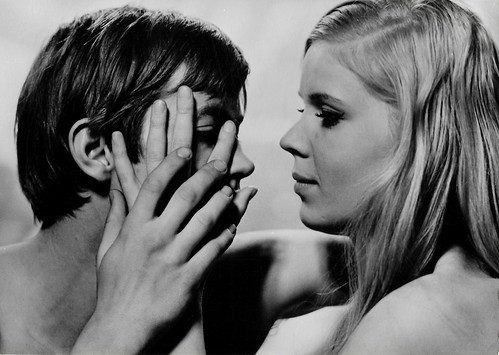
Big East-German card by VEB Progress Film-Vertrieb, Berlin, no. 3281, 1968. Photo: DEFA / Dietrich. Jan Spitzer and Heidemarie Wenzel in Abschied/Farewell (Egon Günther, 1968).
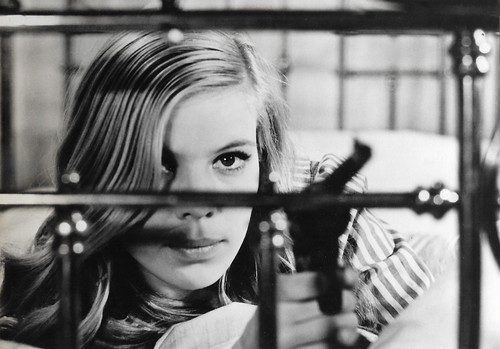
East-German postcard by VEB Progress Film-Vertrieb, Berlin, no. 3282, 1968. Photo: DEFA / Dietrich. Jan Spitzer and Heidemarie Wenzel in Abschied/Farewell (Egon Günther, 1968).
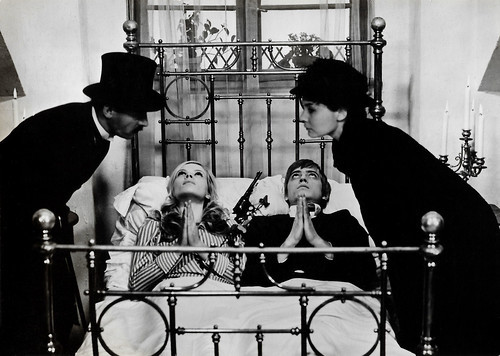
East-German postcard by VEB Progress Film-Vertrieb, Berlin, no. 3283, 1968. Photo: DEFA / Dietrich. Jan Spitzer and Heidemarie Wenzel in Abschied/Farewell (Egon Günther, 1968).
Considered politically unreliable
Until the mid-1970s, Heidemarie Wenzel played several more major roles, but then she got less and less good offers, as she was considered politically unreliable by the state.
In 1986 she made an exit request and was not occupied in the following years. Therefore, she had to work as an office assistant at the church.
In 1988 she was expatriated to the Federal Republic (West-Germany). From 1991, she became a star in both West and East Germany in the TV series Unsere Hagenbecks/Our Hagenbecks (1991-1994) about a family who runs a zoo in Hamburg. When her character died in an accident, it came to public protests.
In the 1990s Wenzel also appeared more often in the theatre. Her later series include the popular hospital soap In aller Freundschaft/In all Friendliness (1998) with Rolf Becker. The series follows the staff of the fictional Sachsenklinik hospital in the city of Leipzig.
Wenzel lives in Berlin-Tempelhof. She has a son and a daughter. In her first marriage Wenzel was married to the director Kurt Veth, which is why she was also credited at times as Heidemarie Wenzel-Veth. Since 1977, she is married to the director and author Helmut Nitzschke.
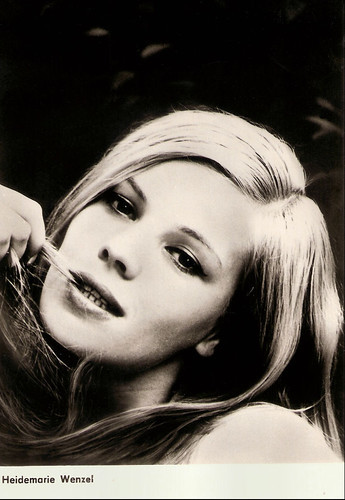
East-German postcard by VEB Progress Film-Vertrieb, Berlin, no. 3267, 1968. Retail price: MDN 0,20. Photo: Balinski.
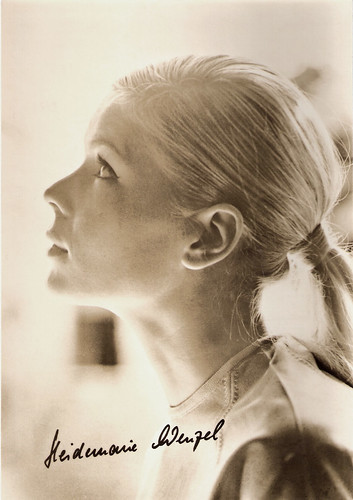
Big East-German card by VEB Progress Film-Vertrieb, Berlin, no. 207/69, 1969. Retail price: 0,40 MDN. Photo: Uhlenhut.
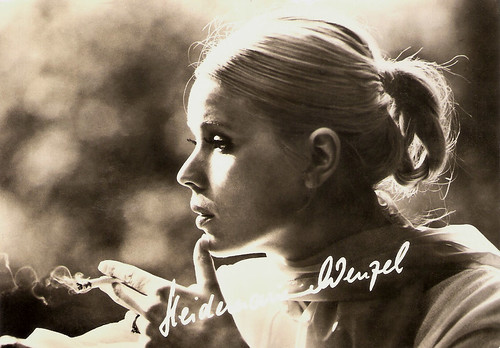
East-German postcard by VEB Progress Film-Vertrieb, Berlin, no. 14/71, 1970. Retail price: 0,20 MDN. Photo: Uhlenhut.
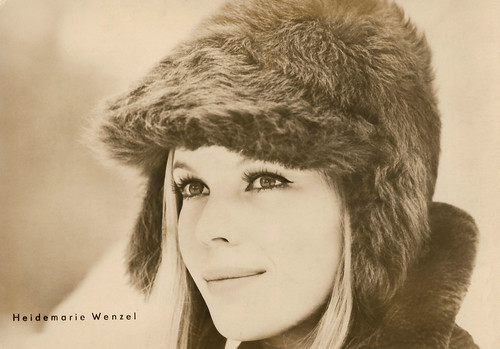
East-German postcard by VEB Progress Film-Vertrieb, Berlin, no. 167/70, 1970. Retail price: 0,20 MDN. Photo: Uhlenhut.
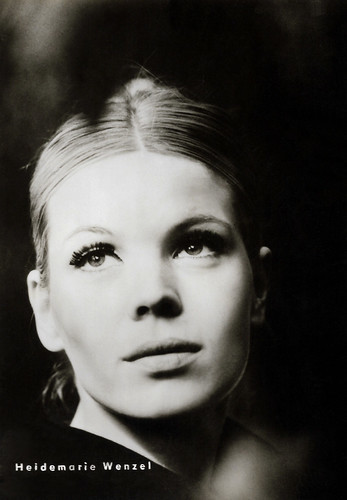
East-German postcard by VEB Progress Film-Vertrieb, Berlin, no. 165/71, 1971. Retail price: M 0,20. Photo: Uhlenhut.
Sources: Wikipedia (German) and .

East-German postcard by VEB Progress Film-Vertrieb, Berlin, no. 3302, 1968, 1971. Retail price: M 0,20. Photo: Schwarz.

East-German postcard by VEB Progress Film-Vertrieb, Berlin / VEB Bild und Heimat Reichenbach, no. 5/F/73, 1973. Retail price: 0,20 M. Photo: Uhlenhut.

East-German postcard by VEB Progress Film-Vertrieb, Berlin, no. 87/75, 1975. Retail price: 0,20 M. Photo: Uhlenhut.
Open-minded and intelligent as well as introverted
Heidemarie Wenzel was born in 1945 in Berlin, Germany. During her youth, she played in the children's theatre and in the movement choir of the Deutschen Staatsoper (German State Opera).
From 1963 to 1966 she studied at the Hochschule für Schauspielkunst Ernst Busch (Ernst Busch Academy of Dramatic Arts) in Berlin. After graduation she got her first engagements in Rostock and Greifswald.
Very soon she began to work as a freelance actress in film and on television. Her first major role was as Fanny in the film adaptation of Johannes R. Becher's novel Abschied/Farewell (Egon Günther, 1968), starring Rolf Ludwig and Jan Spitzer . The film was heavily criticised by officials in the GDR because of the unusual narrative style.
Wenzel had her breakthrough in the role of the self-confident teacher Susanne in Zeit der Störche/Time of the storks (Siegfried Kühn, 1971), opposite Winfried Glatzeder .
In Die Taube auf dem Dach/The Dove on the Roof (Iris Gusner, 1973), she was able to show her acting talent properly for the first time, but the film was banned even before its premiere.
The pretty, tall, slender and blonde actress was both open-minded and intelligent as well as introverted. She was often cast for contemporary roles as in Die Legende von Paul und Paula/The Legend of Paul und Paula (Heiner Carow, 1973), starring Angelica Domröse and Winfried Glatzeder . This was the most successful film of the DEFA in its history.

Big East-German card by VEB Progress Film-Vertrieb, Berlin, no. 3281, 1968. Photo: DEFA / Dietrich. Jan Spitzer and Heidemarie Wenzel in Abschied/Farewell (Egon Günther, 1968).

East-German postcard by VEB Progress Film-Vertrieb, Berlin, no. 3282, 1968. Photo: DEFA / Dietrich. Jan Spitzer and Heidemarie Wenzel in Abschied/Farewell (Egon Günther, 1968).

East-German postcard by VEB Progress Film-Vertrieb, Berlin, no. 3283, 1968. Photo: DEFA / Dietrich. Jan Spitzer and Heidemarie Wenzel in Abschied/Farewell (Egon Günther, 1968).
Considered politically unreliable
Until the mid-1970s, Heidemarie Wenzel played several more major roles, but then she got less and less good offers, as she was considered politically unreliable by the state.
In 1986 she made an exit request and was not occupied in the following years. Therefore, she had to work as an office assistant at the church.
In 1988 she was expatriated to the Federal Republic (West-Germany). From 1991, she became a star in both West and East Germany in the TV series Unsere Hagenbecks/Our Hagenbecks (1991-1994) about a family who runs a zoo in Hamburg. When her character died in an accident, it came to public protests.
In the 1990s Wenzel also appeared more often in the theatre. Her later series include the popular hospital soap In aller Freundschaft/In all Friendliness (1998) with Rolf Becker. The series follows the staff of the fictional Sachsenklinik hospital in the city of Leipzig.
Wenzel lives in Berlin-Tempelhof. She has a son and a daughter. In her first marriage Wenzel was married to the director Kurt Veth, which is why she was also credited at times as Heidemarie Wenzel-Veth. Since 1977, she is married to the director and author Helmut Nitzschke.

East-German postcard by VEB Progress Film-Vertrieb, Berlin, no. 3267, 1968. Retail price: MDN 0,20. Photo: Balinski.

Big East-German card by VEB Progress Film-Vertrieb, Berlin, no. 207/69, 1969. Retail price: 0,40 MDN. Photo: Uhlenhut.

East-German postcard by VEB Progress Film-Vertrieb, Berlin, no. 14/71, 1970. Retail price: 0,20 MDN. Photo: Uhlenhut.

East-German postcard by VEB Progress Film-Vertrieb, Berlin, no. 167/70, 1970. Retail price: 0,20 MDN. Photo: Uhlenhut.

East-German postcard by VEB Progress Film-Vertrieb, Berlin, no. 165/71, 1971. Retail price: M 0,20. Photo: Uhlenhut.
Sources: Wikipedia (German) and .
Published on February 02, 2020 22:00
February 1, 2020
John Wayne
American actor John Wayne (1907-1979) was one of the most popular film stars of the 20th century. He received his first leading film role in The Big Trail (1930). Working with John Ford, he got his next big break in Stagecoach (1939). His career as an actor took another leap forward when he worked with director Howard Hawks in Red River (1948). Wayne won his first Academy Award in 1969. He starred in 142 films altogether and remains a popular American icon to this day.
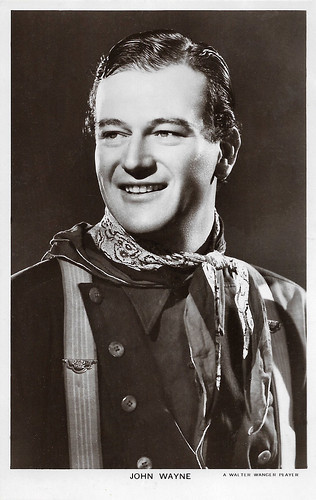
British postcard in the Picturegoer Series, London, no. 797b. Photo: Walter Wanger. John Wayne in Stagecoach (John Ford, 1939).
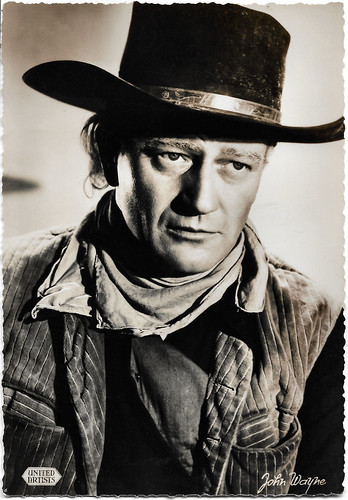
Belgian postcard by Fotoprim, Bruxelles (Brussels), no. 7. Photo: United Artists. John Wayne in Red River (Howard Hawks, 1948).
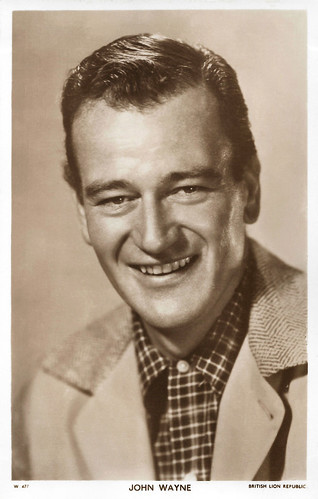
British postcard in the Picturegoer series, London, no W 477. Photo: British Lion / Republic Pictures.
Toiling in numerous Poverty Row Westerns
John Wayne was born Marion Robert Morrison in 1907, in Winterset, Iowa. Some sources also list him as Marion Michael Morrison and Marion Mitchell Morrison. He was already a sizable presence when he was born, weighing around 13 pounds. Marion was the oldest of their two children.
The family moved to Lancester, California, when Marion was around the age of seven. The family moved again a few years later after Clyde failed in his attempt to become a farmer. Settling in Glendale, California, Wayne received his distinctive nickname 'Duke' while living there. He had a dog by that name, and he spent so much time with his pet that the pair became known as 'Little Duke' and 'Big Duke', according to the official John Wayne website.
In high school, Wayne excelled in his classes and in many different activities, including student government and football. He also participated in numerous student theatrical productions. Winning a football scholarship to University of Southern California (USC), Wayne started college in the fall of 1925. Unfortunately, after two years, an injury, a result of a bodysurfing accident, took him off the football field and ended his scholarship.
While in college, Wayne had done some work as a film extra, appearing as a football player in Brown of Harvard (Jack Conway, 1926) with William Haines , and Drop Kick (Millard Webb, 1927), starring Richard Barthelmess . Out of school, Wayne worked as an extra and a prop man in the film industry.
He first met director John Ford while working as an extra on Mother Machree (John Ford, 1928). With the early widescreen film epic The Big Trail (Raoul Walsh, 1930), Wayne received his first leading role, thanks to director Walsh. Raoul Walsh is often credited with helping him create his now legendary screen name, John Wayne. Unfortunately, the Western was a box office failure.
For nearly a decade, Wayne toiled in numerous B-films. He played the lead, with his name over the title, in many low-budget Poverty Row Westerns, mostly at Monogram Pictures and serials for Mascot Pictures Corporation. By Wayne's own estimation, he appeared in about 80 of these horse operas from 1930 to 1939. In Riders of Destiny (Robert N. Bradbury, 1933), he became one of the first singing cowboys of film, named Sandy Saunders, although via dubbing. During this period, Wayne started developing his man of action persona, which would serve as the basis of many popular characters later on.
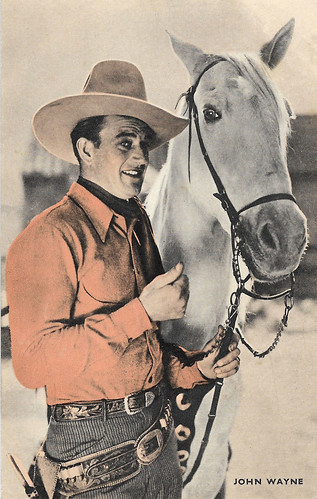
Vintage card.
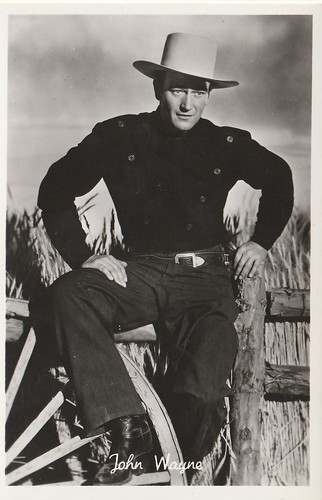
Belgian postcard by Nieuwe Merksemsche Chocolaterie S.P.R.L., Merksem. Photo: Republic Pictures. Caption: "Cette photo vous est offerte par la: Nieuwe Merksemsche Chocolaterie S.P.R.L. Avenue Rerum-Novarum 4, a Merksem (Anvers)." Collection: Daniël van der Aa.
Romantically involved with Marlene Dietrich
Working with John Ford, John Wayne got his next big break in Stagecoach (John Ford, 1939). Because of Wayne's B-film status and track record in low-budget Westerns throughout the 1930s, Ford had difficulty getting financing for what was to be an A-budget film. After rejection by all the major studios, Ford struck a deal with independent producer Walter Wanger in which Claire Trevor, who was a much bigger star at the time, received top billing.
Wayne portrayed the Ringo Kid, an escaped outlaw, who joins an unusual assortment of characters on a dangerous journey through frontier lands. During the trip, the Kid falls for a dance hall prostitute named Dallas (Claire Trevor). The film was well received by filmgoers and critics alike and earned seven Academy Award nominations, including one for Ford's direction. In the end, it took home the awards for Music and for Actor in a Supporting Role for Thomas Mitchell.
Wayne became a mainstream star. Reunited with Ford and Mitchell, Wayne stepped away from his usual Western roles to become a Swedish seaman in The Long Voyage Home (John Ford, 1940). The film was adapted from a play by Eugene O'Neill and follows the crew of a steamer ship as they move a shipment of explosives. Along with many positive reviews, the film earned several Academy Award nominations.
Around this time, Wayne made the first of several films with German star Marlene Dietrich . The two appeared together in Seven Sinners (Tay Garnett, 1940) with Wayne playing a naval officer and Dietrich as a woman who sets out to seduce him. Off-screen, they became romantically involved, though Wayne was married at the time. There had been rumours about Wayne having other affairs, but nothing as substantial as his connection to Dietrich. Even after their physical relationship ended, the pair remained good friends and co-starred in two more films, Pittsburgh (Lewis Seiler, 1942) and The Spoilers (Ray Enright, 1942).
Wayne's first color film was Shepherd of the Hills (Henry Hathaway, 1941), in which he co-starred with his longtime friend Harry Carey. The following year, he appeared in his only film directed by Cecil B. DeMille, the Technicolor epic Reap the Wild Wind (1942), in which he co-starred with Ray Milland and Paulette Goddard; it was one of the rare times he played a character with questionable values.
Wayne started working behind the scenes as a producer in the late 1940s. The first film he produced was Angel and the Badman (James Edward Grant, 1947) with Gail Russell . Over the years, he operated several different production companies, including John Wayne Productions, Wayne-Fellows Productions and Batjac Productions.
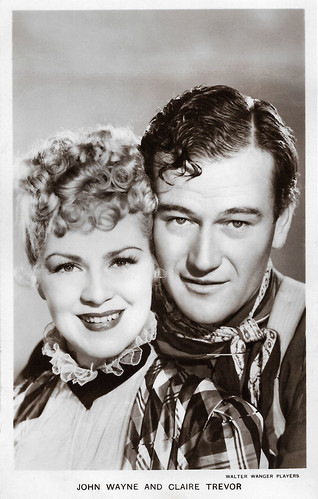
British postcard in the Film Partners Series, London, no. P 289. Photo: Walter Wanger. John Wayne and Claire Trevor in Stagecoach (John Ford, 1939).
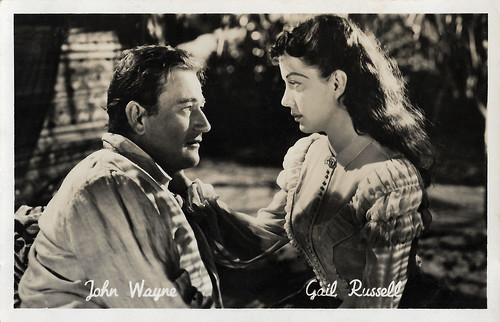
Belgian postcard by Nieuwe Merkemsche Chocolaterie S.P.R.L., Merksem. Photo: Republic Pictures. John Wayne and Gail Russell in Wake of The Red Witch (Edward Ludwig, 1948).
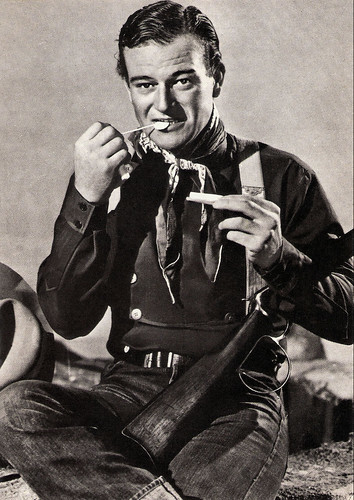
Italian postcard in the Photocards series by Edizioni Beatrice d'Este, no. 20096.
An opportunity to show his talents as an actor
John Wayne's career as an actor took another leap forward when he worked with director Howard Hawks in Red River (1948). The Western drama provided Wayne with an opportunity to show his talents as an actor, not just an action hero. Playing the conflicted cattleman Tom Dunson, he took on a darker sort of character. He deftly handled his character's slow collapse and difficult relationship with his adopted son played by Montgomery Clift.
Also around this time, Wayne also received praise for his work in John Ford's Fort Apache (1948) with Henry Fonda and Shirley Temple . Taking on a war drama, Wayne gave a strong performance in Sands of Iwo Jima (Allan Dwan, 1949), which garnered him his first Academy Award nomination for Best Actor.
He also appeared in more two Westerns by Ford now considered classics: She Wore a Yellow Ribbon (John Ford, 1949) and Rio Grande (John Ford, 1950) with Maureen O'Hara . Wayne worked with O'Hara on several films, perhaps most notably The Quiet Man (John Ford, 1952). Playing an American boxer with a bad reputation, his character moved to Ireland where he fell in love with a local woman ( Maureen O'Hara ). This film is considered Wayne's most convincing leading romantic role by many critics.
A well-known conservative and anticommunist, Wayne merged his personal beliefs and his professional life in Big Jim McLain (Edward Ludwig, 1952). He played an investigator working for the U.S. House Un-American Activities Committee, which worked to root out communists in all aspects of public life. Off screen, Wayne played a leading role in the Motion Picture Alliance for the Preservation of American Ideals and even served as its president for a time. The organisation was a group of conservatives who wanted to stop communists from working in the film industry, and other members included Gary Cooper and Ronald Reagan.
In 1956, Wayne starred in another Ford Western, The Searchers (John Ford, 1956). He played Civil War veteran Ethan Edwards whose niece (Natalie Wood) is abducted by a tribe of Comanches and he again showed some dramatic range as the morally questionable veteran. He soon after reteamed with Howard Hawks for Rio Bravo (1959). Playing a local sheriff, Wayne's character must face off against a powerful rancher and his henchmen who want to free his jailed brother. The unusual cast included Dean Martin and Angie Dickinson .
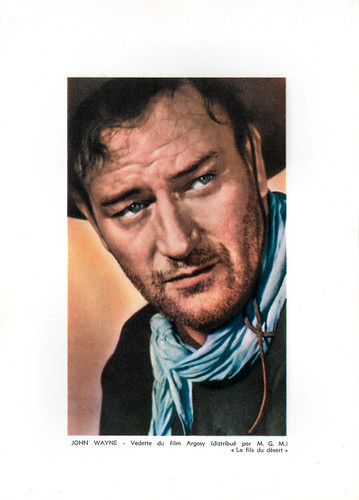
Belgian collectors card. Photo: Argosy / M.G.M. John Wayne in 3 Godfathers (John Ford, 1948).
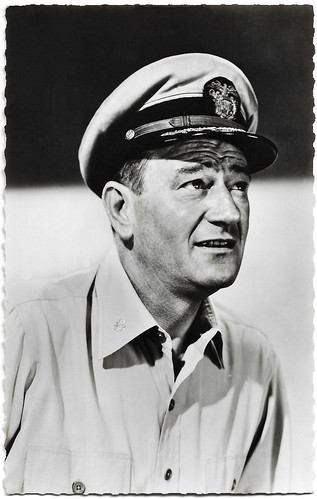
French postcard by Editions P.I., presented by Les Carbones Korès 'Carboplane', no. 839. Photo: Browning Studio / H.P.S. John Wayne in Operation Pacific (George Waggner, 1951).
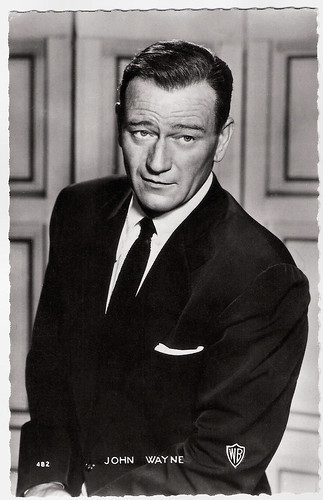
French postcard by P.I., Paris, presented by Les Carbones Korès, no. 482. Photo: Warner Bros, 1953. John Wayne in Trouble Along the Way (Michael Curtiz, 1953).
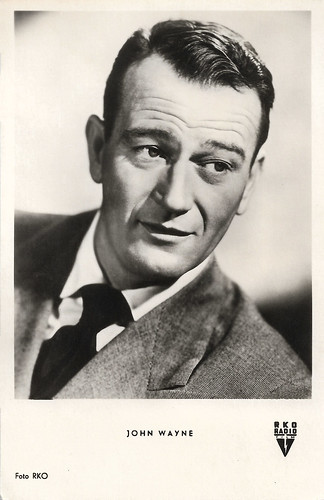
German postcard by Kunst und Bild, Berlin, no. A 473. Photo: RKO Radio Films.
Refusing to even let illness slow him down
John Wayne made his directorial debut with The Alamo (John Wayne, 1960). Starring in the film as Davy Crockett, he received decidedly mixed reviews for both his on- and off-screen efforts. Wayne received a much warmer reception for The Man Who Shot Liberty Valance (John Ford, 1962) in which he played a troubled rancher competing with a lawyer (James Stewart) for a woman's hand in marriage.
Some other notable films from this period include the epics The Longest Day (Ken Annakin, Andrew Marton, Bernhard Wicki, 1962) and How the West Was Won (John Ford, Henry Hathaway, George Marshall, 1962). Continuing to work steadily, Wayne refused to even let illness slow him down. He successfully battled lung cancer in 1964. To defeat the disease, Wayne had to have a lung and several ribs removed.
In the later part of the 1960s, Wayne had some great successes and failures. He co-starred with Robert Mitchum in El Dorado (Howard Hawks, 1967), which was well received. The next year, Wayne again mixed the professional and the political with the pro-Vietnam War film The Green Berets (Ray Kellogg, John Wayne, 1968). He directed and produced as well as starred in the film, which was derided by critics for being heavy handed and clichéd. Viewed by many as a piece of propaganda, the film still did well at the box office.
Around this time, Wayne continued to espouse his conservative political views. He supported his friend Ronald Reagan in his 1966 bid for governor of California as well as his 1970 re-election effort. In 1976, Wayne recorded radio advertisements for Reagan's first attempt to become the Republican presidential candidate.
Wayne won his first Academy Award for Best Actor for True Grit (Henry Hathaway, 1969). He played Rooster Cogburn, an one-eyed marshal and drunkard, who helps a young woman named Mattie (Kim Darby) track down her father's killer. A young Glen Campbell joined the pair on their mission. Rounding out the cast, Robert Duvall and Dennis Hopper were among the bad guys the trio had to defeat.
A later sequel with Katharine Hepburn , Rooster Cogburn (Stuart Millar, 1975), failed to attract critical acclaim or much of an audience. Wayne portrayed an ageing gunfighter dying of cancer in his final film, The Shootist (Don Siegel, 1976), with James Stewart and Lauren Bacall. His character, John Bernard Books, hoped to spend his final days peacefully, but got involved one last gunfight.
In 1978, life imitated art with Wayne being diagnosed with stomach cancer. John Wayne died in 1979, in Los Angeles, California. He was survived by his seven children from two of his three marriages. During his marriage to Josephine Saenz from 1933 to 1945, the couple had four children, two daughters Antonia and Melinda and two sons Michael and Patrick. Both Michael and Patrick followed in their father's footsteps: Michael Wayne as a producer and Patrick Wayne as an actor. With his third wife, Pilar Palette, he had three more children, Ethan, Aissa, and Marisa. Ethan Wayne has worked as an actor over the years.
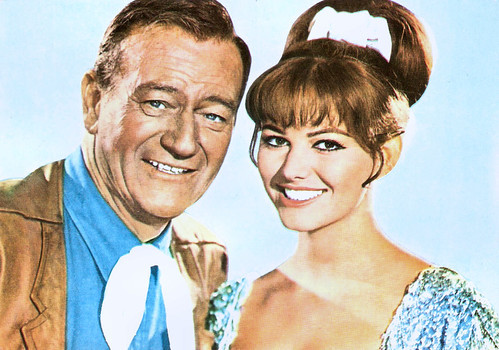
Romanian postcard by Casa Filmului Acin. Claudia Cardinale and John Wayne in Circus World (Henry Hathaway, 1964).
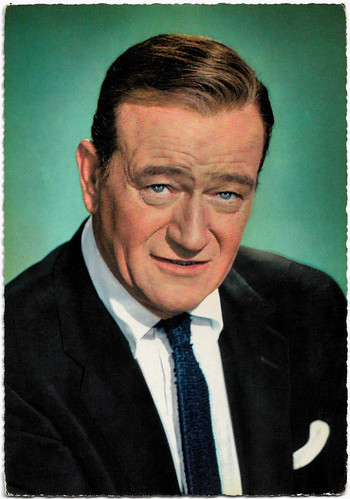
West-German postcard by Krüger, no. 902/259.
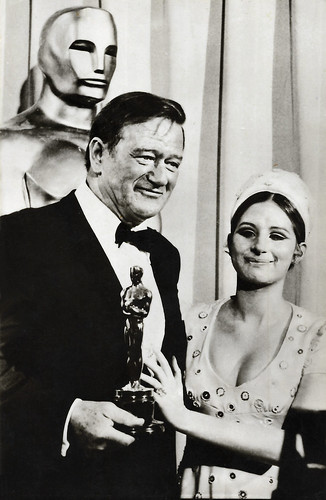
Romanian postcard by Casa Filmului Acin, no. 554, no. 7. John Wayne and Barbra Streisand during the Oscars ceremony 1970. Streisand presented the Best Actor award to Wayne on the 42nd Academy Awards show. Wayne won the Oscar for his performance in True Grit (Henry Hathaway, 1969).
Sources: Biography.com, Wikipedia and .

British postcard in the Picturegoer Series, London, no. 797b. Photo: Walter Wanger. John Wayne in Stagecoach (John Ford, 1939).

Belgian postcard by Fotoprim, Bruxelles (Brussels), no. 7. Photo: United Artists. John Wayne in Red River (Howard Hawks, 1948).

British postcard in the Picturegoer series, London, no W 477. Photo: British Lion / Republic Pictures.
Toiling in numerous Poverty Row Westerns
John Wayne was born Marion Robert Morrison in 1907, in Winterset, Iowa. Some sources also list him as Marion Michael Morrison and Marion Mitchell Morrison. He was already a sizable presence when he was born, weighing around 13 pounds. Marion was the oldest of their two children.
The family moved to Lancester, California, when Marion was around the age of seven. The family moved again a few years later after Clyde failed in his attempt to become a farmer. Settling in Glendale, California, Wayne received his distinctive nickname 'Duke' while living there. He had a dog by that name, and he spent so much time with his pet that the pair became known as 'Little Duke' and 'Big Duke', according to the official John Wayne website.
In high school, Wayne excelled in his classes and in many different activities, including student government and football. He also participated in numerous student theatrical productions. Winning a football scholarship to University of Southern California (USC), Wayne started college in the fall of 1925. Unfortunately, after two years, an injury, a result of a bodysurfing accident, took him off the football field and ended his scholarship.
While in college, Wayne had done some work as a film extra, appearing as a football player in Brown of Harvard (Jack Conway, 1926) with William Haines , and Drop Kick (Millard Webb, 1927), starring Richard Barthelmess . Out of school, Wayne worked as an extra and a prop man in the film industry.
He first met director John Ford while working as an extra on Mother Machree (John Ford, 1928). With the early widescreen film epic The Big Trail (Raoul Walsh, 1930), Wayne received his first leading role, thanks to director Walsh. Raoul Walsh is often credited with helping him create his now legendary screen name, John Wayne. Unfortunately, the Western was a box office failure.
For nearly a decade, Wayne toiled in numerous B-films. He played the lead, with his name over the title, in many low-budget Poverty Row Westerns, mostly at Monogram Pictures and serials for Mascot Pictures Corporation. By Wayne's own estimation, he appeared in about 80 of these horse operas from 1930 to 1939. In Riders of Destiny (Robert N. Bradbury, 1933), he became one of the first singing cowboys of film, named Sandy Saunders, although via dubbing. During this period, Wayne started developing his man of action persona, which would serve as the basis of many popular characters later on.

Vintage card.

Belgian postcard by Nieuwe Merksemsche Chocolaterie S.P.R.L., Merksem. Photo: Republic Pictures. Caption: "Cette photo vous est offerte par la: Nieuwe Merksemsche Chocolaterie S.P.R.L. Avenue Rerum-Novarum 4, a Merksem (Anvers)." Collection: Daniël van der Aa.
Romantically involved with Marlene Dietrich
Working with John Ford, John Wayne got his next big break in Stagecoach (John Ford, 1939). Because of Wayne's B-film status and track record in low-budget Westerns throughout the 1930s, Ford had difficulty getting financing for what was to be an A-budget film. After rejection by all the major studios, Ford struck a deal with independent producer Walter Wanger in which Claire Trevor, who was a much bigger star at the time, received top billing.
Wayne portrayed the Ringo Kid, an escaped outlaw, who joins an unusual assortment of characters on a dangerous journey through frontier lands. During the trip, the Kid falls for a dance hall prostitute named Dallas (Claire Trevor). The film was well received by filmgoers and critics alike and earned seven Academy Award nominations, including one for Ford's direction. In the end, it took home the awards for Music and for Actor in a Supporting Role for Thomas Mitchell.
Wayne became a mainstream star. Reunited with Ford and Mitchell, Wayne stepped away from his usual Western roles to become a Swedish seaman in The Long Voyage Home (John Ford, 1940). The film was adapted from a play by Eugene O'Neill and follows the crew of a steamer ship as they move a shipment of explosives. Along with many positive reviews, the film earned several Academy Award nominations.
Around this time, Wayne made the first of several films with German star Marlene Dietrich . The two appeared together in Seven Sinners (Tay Garnett, 1940) with Wayne playing a naval officer and Dietrich as a woman who sets out to seduce him. Off-screen, they became romantically involved, though Wayne was married at the time. There had been rumours about Wayne having other affairs, but nothing as substantial as his connection to Dietrich. Even after their physical relationship ended, the pair remained good friends and co-starred in two more films, Pittsburgh (Lewis Seiler, 1942) and The Spoilers (Ray Enright, 1942).
Wayne's first color film was Shepherd of the Hills (Henry Hathaway, 1941), in which he co-starred with his longtime friend Harry Carey. The following year, he appeared in his only film directed by Cecil B. DeMille, the Technicolor epic Reap the Wild Wind (1942), in which he co-starred with Ray Milland and Paulette Goddard; it was one of the rare times he played a character with questionable values.
Wayne started working behind the scenes as a producer in the late 1940s. The first film he produced was Angel and the Badman (James Edward Grant, 1947) with Gail Russell . Over the years, he operated several different production companies, including John Wayne Productions, Wayne-Fellows Productions and Batjac Productions.

British postcard in the Film Partners Series, London, no. P 289. Photo: Walter Wanger. John Wayne and Claire Trevor in Stagecoach (John Ford, 1939).

Belgian postcard by Nieuwe Merkemsche Chocolaterie S.P.R.L., Merksem. Photo: Republic Pictures. John Wayne and Gail Russell in Wake of The Red Witch (Edward Ludwig, 1948).

Italian postcard in the Photocards series by Edizioni Beatrice d'Este, no. 20096.
An opportunity to show his talents as an actor
John Wayne's career as an actor took another leap forward when he worked with director Howard Hawks in Red River (1948). The Western drama provided Wayne with an opportunity to show his talents as an actor, not just an action hero. Playing the conflicted cattleman Tom Dunson, he took on a darker sort of character. He deftly handled his character's slow collapse and difficult relationship with his adopted son played by Montgomery Clift.
Also around this time, Wayne also received praise for his work in John Ford's Fort Apache (1948) with Henry Fonda and Shirley Temple . Taking on a war drama, Wayne gave a strong performance in Sands of Iwo Jima (Allan Dwan, 1949), which garnered him his first Academy Award nomination for Best Actor.
He also appeared in more two Westerns by Ford now considered classics: She Wore a Yellow Ribbon (John Ford, 1949) and Rio Grande (John Ford, 1950) with Maureen O'Hara . Wayne worked with O'Hara on several films, perhaps most notably The Quiet Man (John Ford, 1952). Playing an American boxer with a bad reputation, his character moved to Ireland where he fell in love with a local woman ( Maureen O'Hara ). This film is considered Wayne's most convincing leading romantic role by many critics.
A well-known conservative and anticommunist, Wayne merged his personal beliefs and his professional life in Big Jim McLain (Edward Ludwig, 1952). He played an investigator working for the U.S. House Un-American Activities Committee, which worked to root out communists in all aspects of public life. Off screen, Wayne played a leading role in the Motion Picture Alliance for the Preservation of American Ideals and even served as its president for a time. The organisation was a group of conservatives who wanted to stop communists from working in the film industry, and other members included Gary Cooper and Ronald Reagan.
In 1956, Wayne starred in another Ford Western, The Searchers (John Ford, 1956). He played Civil War veteran Ethan Edwards whose niece (Natalie Wood) is abducted by a tribe of Comanches and he again showed some dramatic range as the morally questionable veteran. He soon after reteamed with Howard Hawks for Rio Bravo (1959). Playing a local sheriff, Wayne's character must face off against a powerful rancher and his henchmen who want to free his jailed brother. The unusual cast included Dean Martin and Angie Dickinson .

Belgian collectors card. Photo: Argosy / M.G.M. John Wayne in 3 Godfathers (John Ford, 1948).

French postcard by Editions P.I., presented by Les Carbones Korès 'Carboplane', no. 839. Photo: Browning Studio / H.P.S. John Wayne in Operation Pacific (George Waggner, 1951).

French postcard by P.I., Paris, presented by Les Carbones Korès, no. 482. Photo: Warner Bros, 1953. John Wayne in Trouble Along the Way (Michael Curtiz, 1953).

German postcard by Kunst und Bild, Berlin, no. A 473. Photo: RKO Radio Films.
Refusing to even let illness slow him down
John Wayne made his directorial debut with The Alamo (John Wayne, 1960). Starring in the film as Davy Crockett, he received decidedly mixed reviews for both his on- and off-screen efforts. Wayne received a much warmer reception for The Man Who Shot Liberty Valance (John Ford, 1962) in which he played a troubled rancher competing with a lawyer (James Stewart) for a woman's hand in marriage.
Some other notable films from this period include the epics The Longest Day (Ken Annakin, Andrew Marton, Bernhard Wicki, 1962) and How the West Was Won (John Ford, Henry Hathaway, George Marshall, 1962). Continuing to work steadily, Wayne refused to even let illness slow him down. He successfully battled lung cancer in 1964. To defeat the disease, Wayne had to have a lung and several ribs removed.
In the later part of the 1960s, Wayne had some great successes and failures. He co-starred with Robert Mitchum in El Dorado (Howard Hawks, 1967), which was well received. The next year, Wayne again mixed the professional and the political with the pro-Vietnam War film The Green Berets (Ray Kellogg, John Wayne, 1968). He directed and produced as well as starred in the film, which was derided by critics for being heavy handed and clichéd. Viewed by many as a piece of propaganda, the film still did well at the box office.
Around this time, Wayne continued to espouse his conservative political views. He supported his friend Ronald Reagan in his 1966 bid for governor of California as well as his 1970 re-election effort. In 1976, Wayne recorded radio advertisements for Reagan's first attempt to become the Republican presidential candidate.
Wayne won his first Academy Award for Best Actor for True Grit (Henry Hathaway, 1969). He played Rooster Cogburn, an one-eyed marshal and drunkard, who helps a young woman named Mattie (Kim Darby) track down her father's killer. A young Glen Campbell joined the pair on their mission. Rounding out the cast, Robert Duvall and Dennis Hopper were among the bad guys the trio had to defeat.
A later sequel with Katharine Hepburn , Rooster Cogburn (Stuart Millar, 1975), failed to attract critical acclaim or much of an audience. Wayne portrayed an ageing gunfighter dying of cancer in his final film, The Shootist (Don Siegel, 1976), with James Stewart and Lauren Bacall. His character, John Bernard Books, hoped to spend his final days peacefully, but got involved one last gunfight.
In 1978, life imitated art with Wayne being diagnosed with stomach cancer. John Wayne died in 1979, in Los Angeles, California. He was survived by his seven children from two of his three marriages. During his marriage to Josephine Saenz from 1933 to 1945, the couple had four children, two daughters Antonia and Melinda and two sons Michael and Patrick. Both Michael and Patrick followed in their father's footsteps: Michael Wayne as a producer and Patrick Wayne as an actor. With his third wife, Pilar Palette, he had three more children, Ethan, Aissa, and Marisa. Ethan Wayne has worked as an actor over the years.

Romanian postcard by Casa Filmului Acin. Claudia Cardinale and John Wayne in Circus World (Henry Hathaway, 1964).

West-German postcard by Krüger, no. 902/259.

Romanian postcard by Casa Filmului Acin, no. 554, no. 7. John Wayne and Barbra Streisand during the Oscars ceremony 1970. Streisand presented the Best Actor award to Wayne on the 42nd Academy Awards show. Wayne won the Oscar for his performance in True Grit (Henry Hathaway, 1969).
Sources: Biography.com, Wikipedia and .
Published on February 01, 2020 22:00
January 31, 2020
Will It Snow in February?
Snowfall can provide a lot of atmosphere for a film. But directors don't want to stand around and wait for the snowflakes. Since the dawn of cinema, filmmakers have been devising new ways to fake it. One early substance used was cotton, until a fireman in 1928 pointed out that it was a bad idea to cover a film set in a flammable material. He had another not-so-bright idea. Why not use asbestos? The idea gained momentum in Hollywood, and from the 1930's through the 1950's, asbestos was marketed as snow under the names "Pure White" and "Snow Drift." But a number of other materials were used over time to make it look as if it was snowy, even on a hot summer’s day on set.
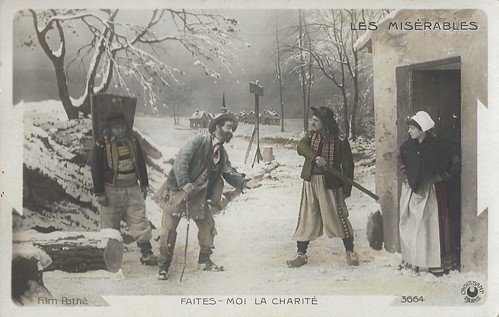
French postcard by Croisant, Paris, no. 3664. Photo: Film Pathé. Publicity still for Le chemineau/The Tramp (Albert Capellani, 1905), based on the first part of Victor Hugo's novel 'Les misérables'. It's winter, snow falls on the desolate countryside. An exhausted tramp in vain asks for an alimony from passers-by. Unclear is who the actors are, but the sets were created by Hugues Laurent.
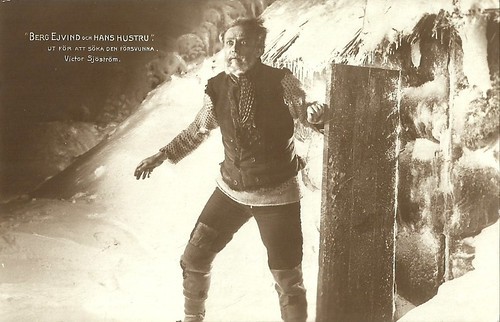
Swedish postcard by Nordisk Konst, Stockholm, no. 844/ 11. Photo: Svenska Biografteatern AB. Victor Sjöström in Berg-Ejvind och hans hustru/The Outlaw and His Wife (Victor Sjöström, 1918). Caption: Out to seek the lost.
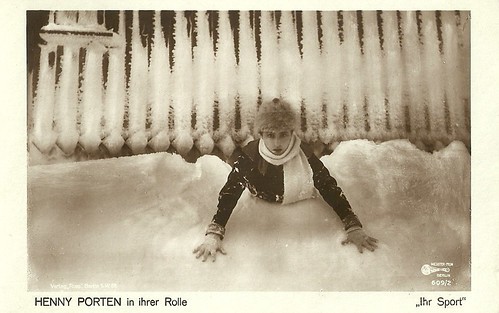
German postcard by Ross Verlag, no. 609/2. Photo: Messter-Film, Berlin. Henny Porten in the romantic comedy Ihr Sport/Her Sport (Rudolf Biebrach, 1919).
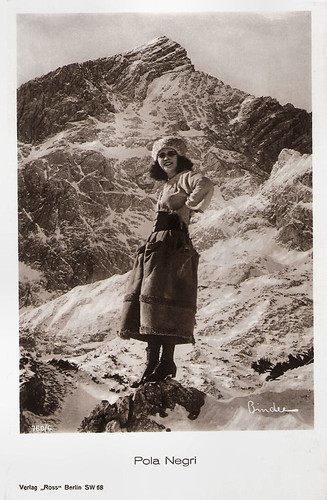
German postcard by Ross Verlag, Berlin, no. 760/6. Photo: Alex Binder. Pola Negri in Die Bergkatze/Wildcat (Ernst Lubitsch, 1921).

German postcard by Ross Verlag, Berlin, no. 677/2. Photo: Decla-Ufa-Film. Kriemhild ( Margarete Schön ) at the spring where Siegfried died in Die Nibelungen, II. Teil, Kriemhilds Rache/Kriemhild's Revenge (Fritz Lang, 1924).
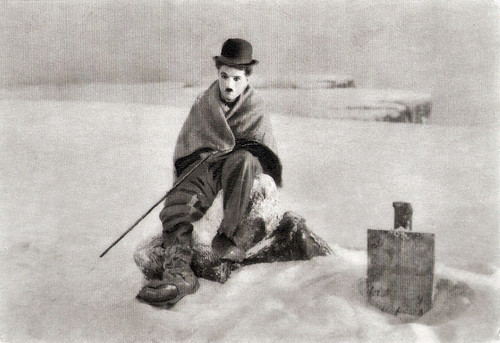
French postcard by Hélio-Cachan. Photo: Charlie Chaplin in The Gold Rush (Charles Chaplin, 1925).
Asbestos as fake snow
The Swedish silent classic Berg-Ejvind och hans hustru/The Outlaw and His Wife (Victor Sjöström, 1918) is based on 'Fjalla-Eyvind' (1911), a play by the Icelandic playwright Jóhann Sigurjónsson. The film is set in Iceland, but was filmed in the North of Sweden, at Åre and Abisko, where fake snow was not needed. The film not only a realist vision of the hardship of nature but also of the intolerance of humans. When the film came out, not only Sjöström's direction but also the cinematography of Julius Jaenzon was praised. French critic Louis Delluc called it the most beautiful film he saw until then, praising the director, the two leading actors and the landscape as 'third protagonist'.
In The Gold Rush (1925), Charles Chaplin found inspiration in the historical Klondike Gold Rush, and led him to drag the production's cast and crew to snowy, rustic Trukee, Nevada to serve as the scenic Chilkoot Pass in Alaska. Chaplin found directing his film difficult to control in the frigid conditions, and after coming down with the flu, he agreed to return to Hollywood.
Once back in the studio, work began on the creation of a miniature mountain range, constructed from timber (reportedly a quarter-of-a-million feet), chicken wire, and burlap. Salt and flour were used in lieu of snow, and the resulting snowscape was surprisingly convincing on film. To film the Miner's hut teetering on the edge of the cliff, studio technicians created a miniature model and filmed the scene so smoothly that the cut from the full-size set to the model is hard to detect.
Victor Fleming's Wizard of Oz (1939) is a Technicolor triumph, but Dorothy's dream hid a nightmare special effect secret. Filming the poppy field scene on stage 29 at MGM's studio required planting 40,000 artificial flowers carefully placed into the floor of the set.
However, the real magic of the scene was the snow, sent by Glinda the Good Witch (Billie Burke) to break the spell placed on Dorothy (Judy Garland) and the Cowardly Lion (Bert Lahr) by the Wicked Witch of the West (Margaret Hamilton). But Glinda may have reconsidered if she knew exactly what she was sending - industrial grade chrysotile, otherwise known as the known cancer-causing substance asbestos, which the crew used as fake snow.
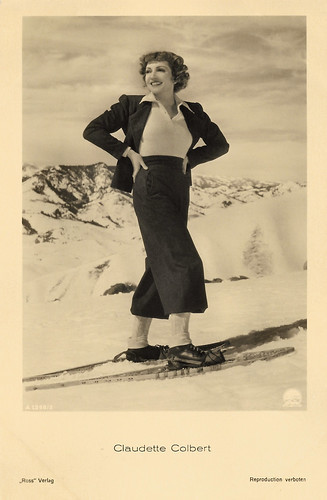
German postcard by Ross Verlag, no. A 1268/2, 1937-1938. Photo: Paramount. Claudette Colbert in I Met Him in Paris (Wesley Ruggles, 1937).

Doris Day . Dutch postcard by Takken, Utrecht, no. 287. Photo: Warner Bros.
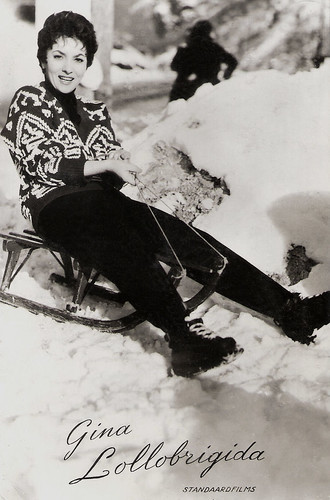
Gina Lollobrigida . Dutch postcard by Uitgeverij Takken, Utrecht, no. 3207. Photo: Standaard Films.
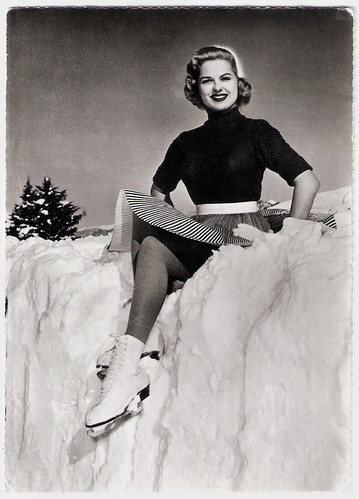
Martha Hyer . Yugoslavian postcard by ZK, no. 2180.
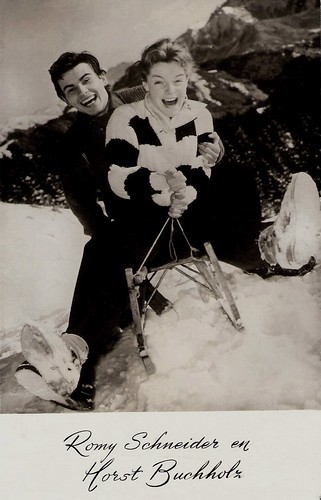
Romy Schneider and Horst Buchholz . Dutch postcard by Uitg. Takken, Utrecht, no. 2077.
Snow during a blistering summer
Shot in Encino, Calif., during a blistering summer, director Frank Capra's It's a Wonderful Life (1947) pioneered a new method for creating fake snow. Capra, working with Russel Sherman, RKO's head of special effects, developed a form of quiet snow specially for the film. Their new 'chemical snow' allowed actors to walk on it without creating the crunching sound typically associated with artificial snow of the time and also with real snow.
To make 'quiet' snow, foamite (used in fire extinguishers) was mixed with water, sugar, and soap flakes. The sprayable foam could then be applied to large areas quickly and efficiently, and could even be blown into the air with wind machines. To complete the effect, shaved ice was used to recreate slushy paths, and tons of plaster was sprayed on trees and used to create unmeltable snowbanks. In 1948, the Academy of Motion Picture Arts and Sciences presented Russel Sherman and the RKO Radio Studio Special Effects Department with a Technical Award for their innovative efforts.
One of the scariest parts of Stanley Kubrick's horror classic The Shining (1980) is that the characters are snowed in at the Overlook Hotel, a desolate winter hideaway, which gives the viewers a sense of claustrophobia. This plays an important part near the end of the film when Jack Torrance ( Jack Nicholson ) is chasing his little son Danny (Danny Lloyd) through the hedge maze in the snow. For Kubrick and his crew it was obviously essential to use fake snow so that nobody became ill because of the temperatures and the crew pulled it off in an effective way. They made the snow from formaldehyde and salt.
The Living Daylights (John Glen, 1987) was the fifteenth film in the James Bond series. It was also the first of two films with Timothy Dalton as 007. Maryam d’Abo co-starred as his Bond's interest. One of our favourite scenes is the one following a crash and dramatic explosion. Bond escapes across the border the slopes of Bratislava, Slovakia, on a cello case that doubles as a sled. He ruins the costly instrument using to bat away bullets, but he makes up for it by whipping his love interest across the Austrian border to safety, holding up his passport and shouting "Nothing to declare!" as they scoot under the barrier.
The cello case was made of fibreglass, had skis on the bottom and control handles on the sides. Special Effects Supervisor John Richardson recalls: "As long as you made sure there was nothing at the bottom of the hill they were liable to crash into, it was actually quite fun to ride it down."
In John Cameron's Titanic (1997) a big hunk of Arctic sea ice is the big enemy. The iceberg easily punches through the Titanic’s super-chilled steel hull through five watertight compartments, allowing thousands of gallons of seawater to surge into the ship. Jack ( Leonardo DiCaprio ) and Rose ( Kate Winslet ) watch as the Iceberg grazes alongside the ship, sending small chunks of ice falling onto the decks.
Without a life jacket, Jack is caught in the suction of Titanic but he makes his way to the surface and reunites with Rose. They manage to swim to a floating door which seems to only be able to support one person's weight, so Rose climbs on top. As time passes many people die from the freezing water. Jack makes Rose promise him that she will never give up. However, the freezing cold water was not cold at all. “The water in the tank was about 80 degrees, so it was really like a pool,” James Cameron explained of the filming of the water scenes. “All of the cold, frigid water was added later.”
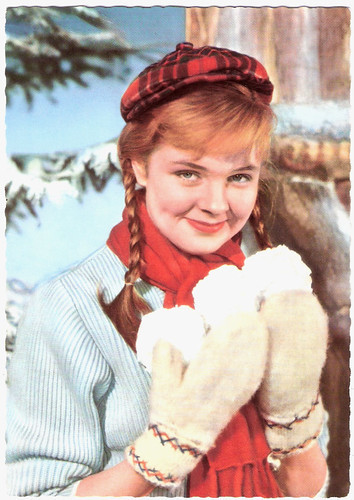
Sabine Sinjen . German postcard by UFA, Berlin-Tempelhoff, no. CK-316. Retail price: 30 Pfg. Photo: Arthur Grimm / UFA.
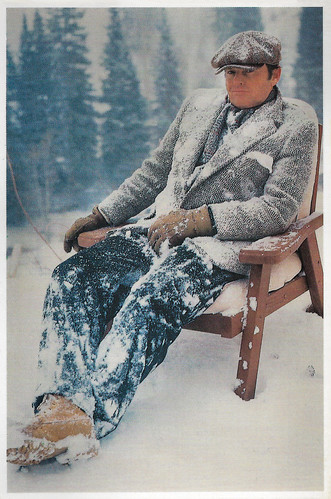
British postcard by World Postcards, no. X253, 1989. Photo: Albert Watson, 1981. Caption: Jack Nicholson , Snow.
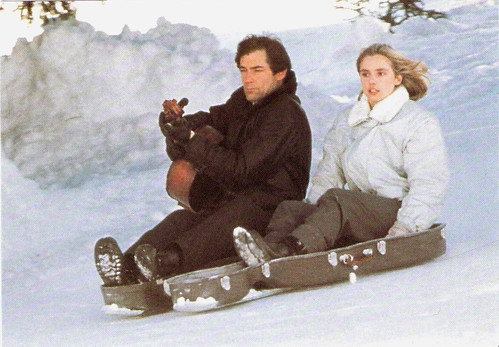
French postcard by Danjaq A.S. / United Artists, 1987. Photo: Timothy Dalton and Maryam d'Abo in The Living Daylights (John Glen, 1987).
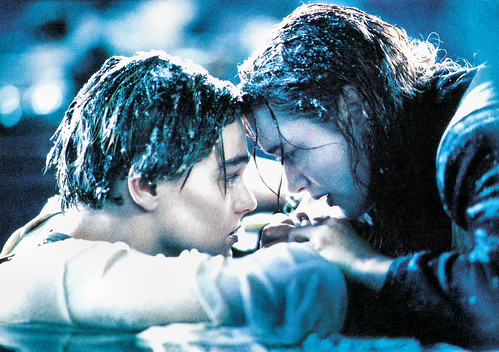
British postcard by Twentieth Century Fox / 7up, no. DD 2079A. Photo: Paramount / Fox. Leonardo DiCaprio and Kate Winslet in Titanic (James Cameron, 1997).
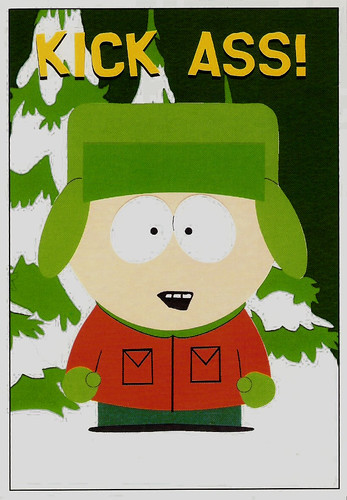
Dutch postcard by Film Freak Productions B.V., no. SP 04. Image: Comedy Central, 1999. Caption: Kick ass! South Park, Kyle.
Sources: Heidi Davis (Popular Mechanics), Kat Eschner (Smithsonian), Lilit Marcus (Mental Floss), The Telegraph, and M16.

French postcard by Croisant, Paris, no. 3664. Photo: Film Pathé. Publicity still for Le chemineau/The Tramp (Albert Capellani, 1905), based on the first part of Victor Hugo's novel 'Les misérables'. It's winter, snow falls on the desolate countryside. An exhausted tramp in vain asks for an alimony from passers-by. Unclear is who the actors are, but the sets were created by Hugues Laurent.

Swedish postcard by Nordisk Konst, Stockholm, no. 844/ 11. Photo: Svenska Biografteatern AB. Victor Sjöström in Berg-Ejvind och hans hustru/The Outlaw and His Wife (Victor Sjöström, 1918). Caption: Out to seek the lost.

German postcard by Ross Verlag, no. 609/2. Photo: Messter-Film, Berlin. Henny Porten in the romantic comedy Ihr Sport/Her Sport (Rudolf Biebrach, 1919).

German postcard by Ross Verlag, Berlin, no. 760/6. Photo: Alex Binder. Pola Negri in Die Bergkatze/Wildcat (Ernst Lubitsch, 1921).

German postcard by Ross Verlag, Berlin, no. 677/2. Photo: Decla-Ufa-Film. Kriemhild ( Margarete Schön ) at the spring where Siegfried died in Die Nibelungen, II. Teil, Kriemhilds Rache/Kriemhild's Revenge (Fritz Lang, 1924).

French postcard by Hélio-Cachan. Photo: Charlie Chaplin in The Gold Rush (Charles Chaplin, 1925).
Asbestos as fake snow
The Swedish silent classic Berg-Ejvind och hans hustru/The Outlaw and His Wife (Victor Sjöström, 1918) is based on 'Fjalla-Eyvind' (1911), a play by the Icelandic playwright Jóhann Sigurjónsson. The film is set in Iceland, but was filmed in the North of Sweden, at Åre and Abisko, where fake snow was not needed. The film not only a realist vision of the hardship of nature but also of the intolerance of humans. When the film came out, not only Sjöström's direction but also the cinematography of Julius Jaenzon was praised. French critic Louis Delluc called it the most beautiful film he saw until then, praising the director, the two leading actors and the landscape as 'third protagonist'.
In The Gold Rush (1925), Charles Chaplin found inspiration in the historical Klondike Gold Rush, and led him to drag the production's cast and crew to snowy, rustic Trukee, Nevada to serve as the scenic Chilkoot Pass in Alaska. Chaplin found directing his film difficult to control in the frigid conditions, and after coming down with the flu, he agreed to return to Hollywood.
Once back in the studio, work began on the creation of a miniature mountain range, constructed from timber (reportedly a quarter-of-a-million feet), chicken wire, and burlap. Salt and flour were used in lieu of snow, and the resulting snowscape was surprisingly convincing on film. To film the Miner's hut teetering on the edge of the cliff, studio technicians created a miniature model and filmed the scene so smoothly that the cut from the full-size set to the model is hard to detect.
Victor Fleming's Wizard of Oz (1939) is a Technicolor triumph, but Dorothy's dream hid a nightmare special effect secret. Filming the poppy field scene on stage 29 at MGM's studio required planting 40,000 artificial flowers carefully placed into the floor of the set.
However, the real magic of the scene was the snow, sent by Glinda the Good Witch (Billie Burke) to break the spell placed on Dorothy (Judy Garland) and the Cowardly Lion (Bert Lahr) by the Wicked Witch of the West (Margaret Hamilton). But Glinda may have reconsidered if she knew exactly what she was sending - industrial grade chrysotile, otherwise known as the known cancer-causing substance asbestos, which the crew used as fake snow.

German postcard by Ross Verlag, no. A 1268/2, 1937-1938. Photo: Paramount. Claudette Colbert in I Met Him in Paris (Wesley Ruggles, 1937).

Doris Day . Dutch postcard by Takken, Utrecht, no. 287. Photo: Warner Bros.

Gina Lollobrigida . Dutch postcard by Uitgeverij Takken, Utrecht, no. 3207. Photo: Standaard Films.

Martha Hyer . Yugoslavian postcard by ZK, no. 2180.

Romy Schneider and Horst Buchholz . Dutch postcard by Uitg. Takken, Utrecht, no. 2077.
Snow during a blistering summer
Shot in Encino, Calif., during a blistering summer, director Frank Capra's It's a Wonderful Life (1947) pioneered a new method for creating fake snow. Capra, working with Russel Sherman, RKO's head of special effects, developed a form of quiet snow specially for the film. Their new 'chemical snow' allowed actors to walk on it without creating the crunching sound typically associated with artificial snow of the time and also with real snow.
To make 'quiet' snow, foamite (used in fire extinguishers) was mixed with water, sugar, and soap flakes. The sprayable foam could then be applied to large areas quickly and efficiently, and could even be blown into the air with wind machines. To complete the effect, shaved ice was used to recreate slushy paths, and tons of plaster was sprayed on trees and used to create unmeltable snowbanks. In 1948, the Academy of Motion Picture Arts and Sciences presented Russel Sherman and the RKO Radio Studio Special Effects Department with a Technical Award for their innovative efforts.
One of the scariest parts of Stanley Kubrick's horror classic The Shining (1980) is that the characters are snowed in at the Overlook Hotel, a desolate winter hideaway, which gives the viewers a sense of claustrophobia. This plays an important part near the end of the film when Jack Torrance ( Jack Nicholson ) is chasing his little son Danny (Danny Lloyd) through the hedge maze in the snow. For Kubrick and his crew it was obviously essential to use fake snow so that nobody became ill because of the temperatures and the crew pulled it off in an effective way. They made the snow from formaldehyde and salt.
The Living Daylights (John Glen, 1987) was the fifteenth film in the James Bond series. It was also the first of two films with Timothy Dalton as 007. Maryam d’Abo co-starred as his Bond's interest. One of our favourite scenes is the one following a crash and dramatic explosion. Bond escapes across the border the slopes of Bratislava, Slovakia, on a cello case that doubles as a sled. He ruins the costly instrument using to bat away bullets, but he makes up for it by whipping his love interest across the Austrian border to safety, holding up his passport and shouting "Nothing to declare!" as they scoot under the barrier.
The cello case was made of fibreglass, had skis on the bottom and control handles on the sides. Special Effects Supervisor John Richardson recalls: "As long as you made sure there was nothing at the bottom of the hill they were liable to crash into, it was actually quite fun to ride it down."
In John Cameron's Titanic (1997) a big hunk of Arctic sea ice is the big enemy. The iceberg easily punches through the Titanic’s super-chilled steel hull through five watertight compartments, allowing thousands of gallons of seawater to surge into the ship. Jack ( Leonardo DiCaprio ) and Rose ( Kate Winslet ) watch as the Iceberg grazes alongside the ship, sending small chunks of ice falling onto the decks.
Without a life jacket, Jack is caught in the suction of Titanic but he makes his way to the surface and reunites with Rose. They manage to swim to a floating door which seems to only be able to support one person's weight, so Rose climbs on top. As time passes many people die from the freezing water. Jack makes Rose promise him that she will never give up. However, the freezing cold water was not cold at all. “The water in the tank was about 80 degrees, so it was really like a pool,” James Cameron explained of the filming of the water scenes. “All of the cold, frigid water was added later.”

Sabine Sinjen . German postcard by UFA, Berlin-Tempelhoff, no. CK-316. Retail price: 30 Pfg. Photo: Arthur Grimm / UFA.

British postcard by World Postcards, no. X253, 1989. Photo: Albert Watson, 1981. Caption: Jack Nicholson , Snow.

French postcard by Danjaq A.S. / United Artists, 1987. Photo: Timothy Dalton and Maryam d'Abo in The Living Daylights (John Glen, 1987).

British postcard by Twentieth Century Fox / 7up, no. DD 2079A. Photo: Paramount / Fox. Leonardo DiCaprio and Kate Winslet in Titanic (James Cameron, 1997).

Dutch postcard by Film Freak Productions B.V., no. SP 04. Image: Comedy Central, 1999. Caption: Kick ass! South Park, Kyle.
Sources: Heidi Davis (Popular Mechanics), Kat Eschner (Smithsonian), Lilit Marcus (Mental Floss), The Telegraph, and M16.
Published on January 31, 2020 22:00
January 30, 2020
16 Misstakes: Who's this Lady?
This month, we had the first Truus, Bob & Jan Too! quiz at Flickr. Our followers could guess who the ladies on 16 postcards were, because all the cards were incorrectly captioned. These vintage 'Mistake' postcards were selected by Ms. Sherlock, our friend Marlene Pilaete. The postcards are all from her personal collection, and Marlene also wrote the comments. Marlene: "Guessing who the ladies really are can be difficult. Personally, regarding several postcards from my collection, it sometimes took me years to identify the actresses."
Mistake 1
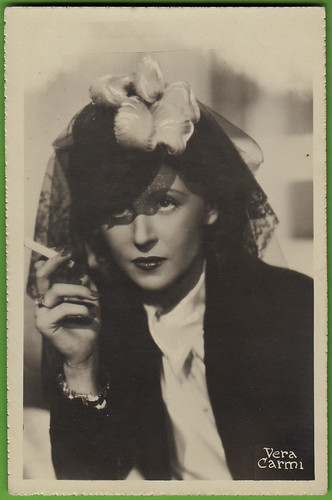
Vintage European card.
This is Annette Bach, not Vera Carmi. This portrait is from the film Labbra serrate/Clenched lips (Mario Mattoli, 1942) in which the two actresses starred together.
Mistake 2
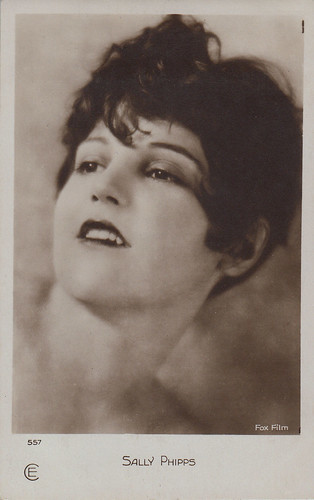
French postcard by Cinémagazine-Edition, Paris, no. 557.
This is Sue Carol, not Sally Phipps. This has been confirmed to me by Sally Phipps's son, Robert Harned, who wrote a very interesting book about his mother in 2015: 'Sally Phipps - Silent Film Star'. Sue Carol and Sally Phipps were both under contract to Fox in the second half of the twenties and, at one time, even sported the same kind of hairdo, hence the confusion.
Mistake 3
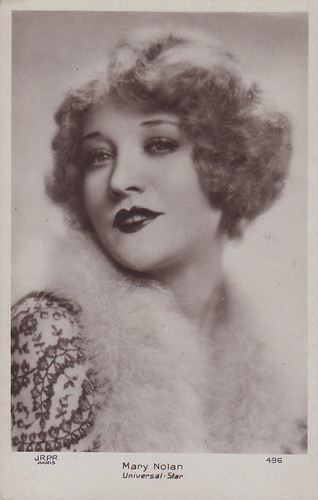
French postcard by JRPR, Paris, no. 93.
This is Betty Compson, not Mary Nolan .
Mistake 4
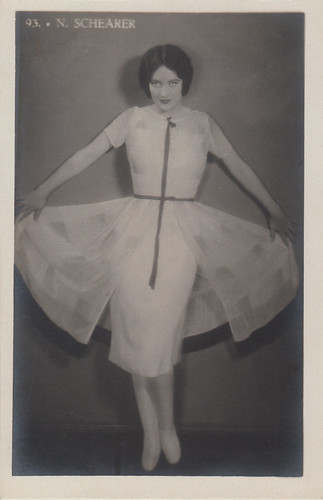
Italian postcard, no, 93.
This is a young Joan Crawford , not Norma Shearer . This mistake is quite funny as those two ladies were not always on friendly terms in real life.
Mistake 5
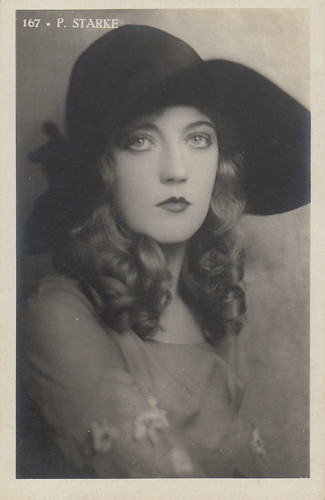
Italian postcard no. 167.
This is Marion Davies , not Pauline Starke.
Mistake 6
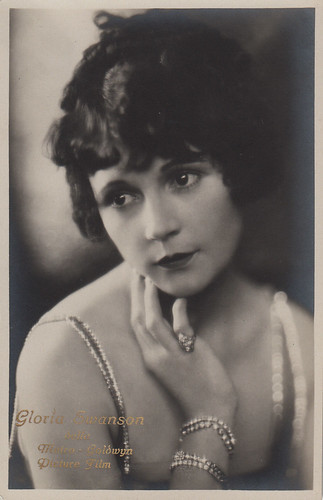
Italian postcard by G.B. Falci, Milano, no. 464.
This is Dorothy Devore, not Gloria Swanson .
Mistake 7
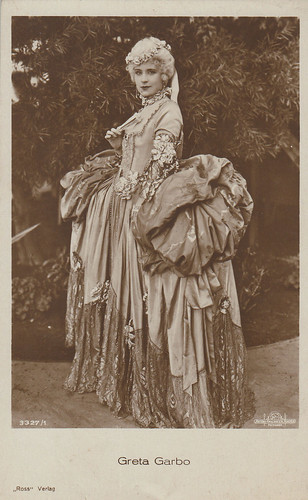
German postcard by Ross Verlag nr 3327/1.
For many years this card stayed very mysterious. It was obvious that this lady was not Greta Garbo . Eventually, the website Rosscards.com gave me the answer: this is Paulette Duval in costume for The Divine Woman (Victor Sjöström, 1928), in which she played with Garbo.
Mistake 8
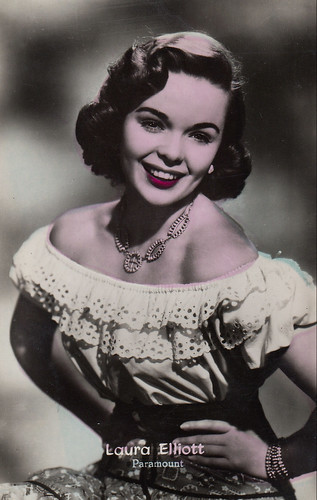
Vintage European postcard.
This is Nancy Gates, not Laura Elliott.
Mistake 9
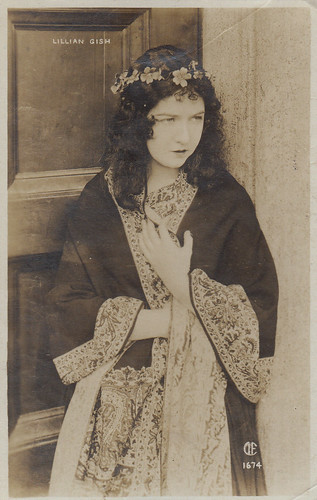
Mexican postcard by C.I.F. no. 1674.
This is indeed one of the Gish sisters but it is Dorothy Gish, not Lillian . This portrait is from the film Romola (Henry King, 1924) in which the two sisters starred together.
Mistake 10
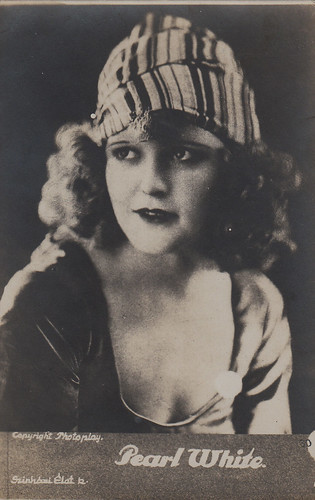
Hungarian postcard by Szinhazi Elet, Budapest.
This is Juanita Hansen, not Pearl White. Both were famous serial queens in the silent movie era.
Mistake 11
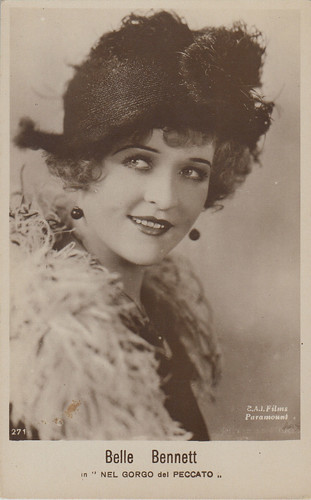
Italian postcard by G.B. Falci, Milano, no. 271.
This is Phyllis Haver, not Belle Bennett. This portrait is from the film Nel gorgo del peccato/The Way of All Flesh (Victor Fleming, 1927) in which the two actresses starred together.
Mistake 12
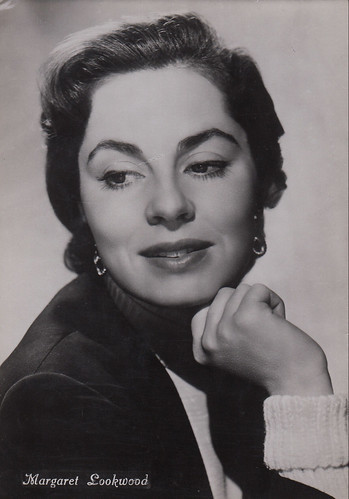
Italian postcard by Vetta Traldi, Milano, no. 67.
This is Viveca Lindfors , not Margaret Lockwood .
Mistake 13
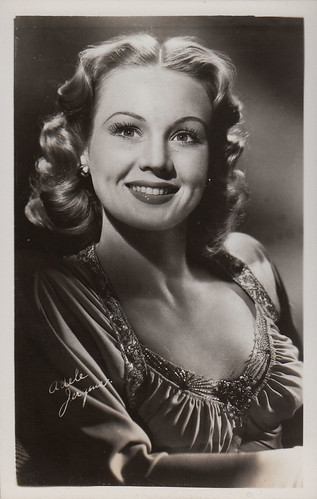
American postcard.
Vintage postcard featuring an alluring blonde 1940s star, but this is Virginia Mayo , not Adele Jergens.
Mistake 14
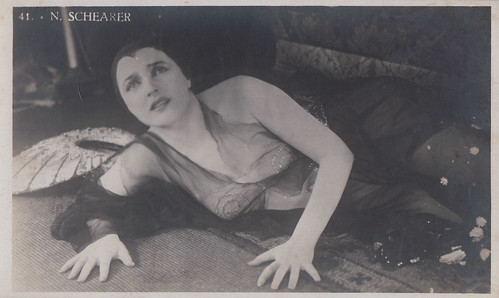
Italian postcard, no. 41.
Italian publishers seemed to see Norma Shearer everywhere. Here again, the card is incorrectly captioned. This is Carmel Myers, in a scene from The Devil's circus (1926), in which she co-starred with Norma Shearer.
Mistake 15
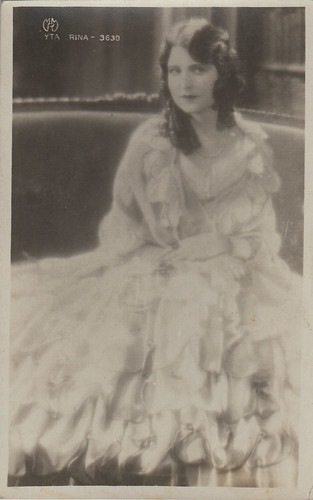
Mexican postcard by M.R.M., no. 3630.
This is Claire Rommer , not Ita Rina . This portrait is from the film Der Walzerkönig/The Waltz King (Manfred Noa, 1930), in which the two actresses starred together.
Mistake 16
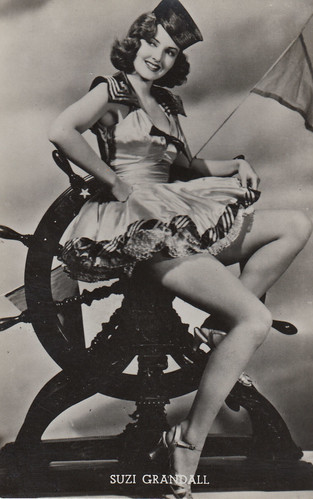
Dutch postcard by van Leer's Fotodrukindustrie N.V., no. 31.
This is Martha Vickers , not Suzi Crandall.
Many thanks to Marlene! If you want to see more of her collection, check out her blog La Collectionneuse. Or check out our album at Flickr: Collection: Marlene Pilaete.
Mistake 1

Vintage European card.
This is Annette Bach, not Vera Carmi. This portrait is from the film Labbra serrate/Clenched lips (Mario Mattoli, 1942) in which the two actresses starred together.
Mistake 2

French postcard by Cinémagazine-Edition, Paris, no. 557.
This is Sue Carol, not Sally Phipps. This has been confirmed to me by Sally Phipps's son, Robert Harned, who wrote a very interesting book about his mother in 2015: 'Sally Phipps - Silent Film Star'. Sue Carol and Sally Phipps were both under contract to Fox in the second half of the twenties and, at one time, even sported the same kind of hairdo, hence the confusion.
Mistake 3

French postcard by JRPR, Paris, no. 93.
This is Betty Compson, not Mary Nolan .
Mistake 4

Italian postcard, no, 93.
This is a young Joan Crawford , not Norma Shearer . This mistake is quite funny as those two ladies were not always on friendly terms in real life.
Mistake 5

Italian postcard no. 167.
This is Marion Davies , not Pauline Starke.
Mistake 6

Italian postcard by G.B. Falci, Milano, no. 464.
This is Dorothy Devore, not Gloria Swanson .
Mistake 7

German postcard by Ross Verlag nr 3327/1.
For many years this card stayed very mysterious. It was obvious that this lady was not Greta Garbo . Eventually, the website Rosscards.com gave me the answer: this is Paulette Duval in costume for The Divine Woman (Victor Sjöström, 1928), in which she played with Garbo.
Mistake 8

Vintage European postcard.
This is Nancy Gates, not Laura Elliott.
Mistake 9

Mexican postcard by C.I.F. no. 1674.
This is indeed one of the Gish sisters but it is Dorothy Gish, not Lillian . This portrait is from the film Romola (Henry King, 1924) in which the two sisters starred together.
Mistake 10

Hungarian postcard by Szinhazi Elet, Budapest.
This is Juanita Hansen, not Pearl White. Both were famous serial queens in the silent movie era.
Mistake 11

Italian postcard by G.B. Falci, Milano, no. 271.
This is Phyllis Haver, not Belle Bennett. This portrait is from the film Nel gorgo del peccato/The Way of All Flesh (Victor Fleming, 1927) in which the two actresses starred together.
Mistake 12

Italian postcard by Vetta Traldi, Milano, no. 67.
This is Viveca Lindfors , not Margaret Lockwood .
Mistake 13

American postcard.
Vintage postcard featuring an alluring blonde 1940s star, but this is Virginia Mayo , not Adele Jergens.
Mistake 14

Italian postcard, no. 41.
Italian publishers seemed to see Norma Shearer everywhere. Here again, the card is incorrectly captioned. This is Carmel Myers, in a scene from The Devil's circus (1926), in which she co-starred with Norma Shearer.
Mistake 15

Mexican postcard by M.R.M., no. 3630.
This is Claire Rommer , not Ita Rina . This portrait is from the film Der Walzerkönig/The Waltz King (Manfred Noa, 1930), in which the two actresses starred together.
Mistake 16

Dutch postcard by van Leer's Fotodrukindustrie N.V., no. 31.
This is Martha Vickers , not Suzi Crandall.
Many thanks to Marlene! If you want to see more of her collection, check out her blog La Collectionneuse. Or check out our album at Flickr: Collection: Marlene Pilaete.
Published on January 30, 2020 22:00
January 29, 2020
Hilda Rosch
German actress Hilda Rosch only appeared in eight films between 1928 and 1931. Rosch co-starred in popular silent films with Harry Liedtke and Luciano Albertini, but she was soon forgotten.
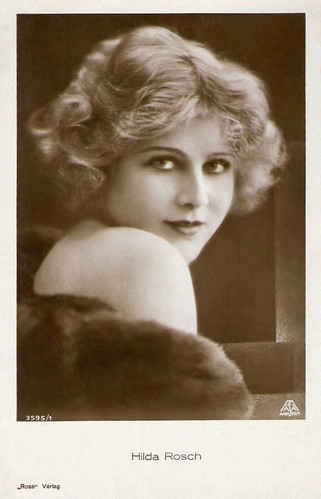
German postcard by Ross Verlag, no. 3595/1, 1928-1929. Photo: Aafa Film.
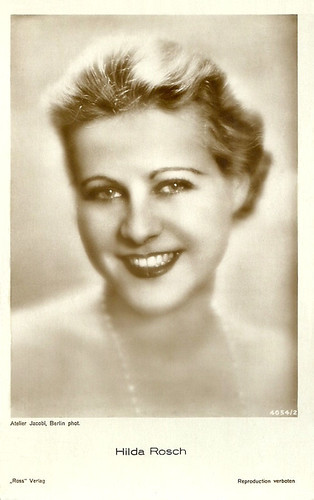
German postcard by Ross Verlag, no. 4054/2, 1929-1930. Photo: Atelier Jacobi, Berlin.
One of these little mysteries in the film history
Hilda Rosch must have been quite a popular film star as several postcards were produced with the beautiful actress.
Why Rosch then appeared in only eight films is one of these little mysteries of the film history.
Her first film was Die Zirkusprinzessin/The Circus Princess (Victor Janson, 1928) with Harry Liedtke, Trude Berliner and Cilly Feindt .
In the same year, Hilda Rosch appeared in the spectacular action films Der Unüberwindliche/The Invincible (Max Obal, 1928), and Tempo! Tempo! (Max Obal, 1929) opposite Italian strong man Luciano Albertini .
In Das Spiel mit der Liebe/The Game of Love (Victor Janson, 1929) she starred in a double role as Miss Lilian Tompson and as Marchesa Beatrice de Castellagain alongside Harry Liedtke .
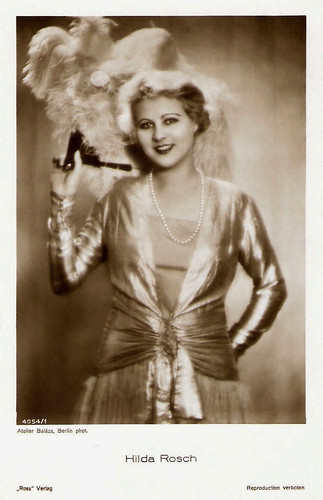
German postcard by Ross Verlag, no. 4054/1, 1929-1930. Photo: Atelier Balázs, Berlin.
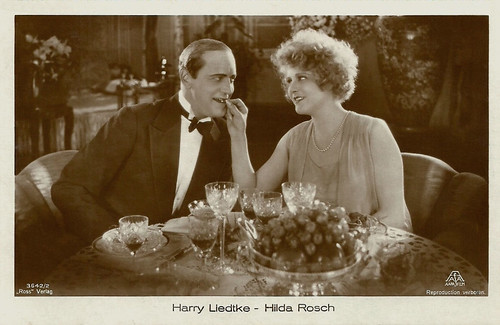
German postcard by Ross Verlag, no. 3642/2, 1928-1929. Photo: Aafa Film. Harry Liedtke and Hilda Rosch in Das Spiel mit der Liebe/The Game with Love (Victor Janson, 1928).
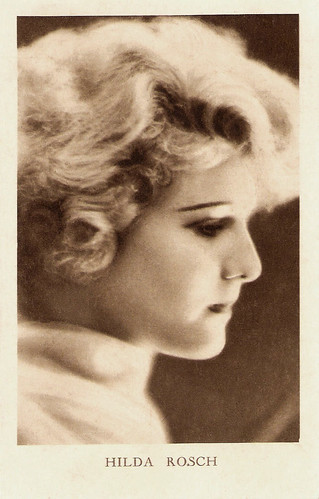
Belgian postcard by Weekblad 'Cinema', Antwerpen (Antwerp).
Abrupt End
Hilda Rosch's film career developed nicely. She appeared opposite cabaret star Max Hansen in the short Max Hansen: Jetzt geht's der Dolly gut/Max Hansen: Now Dolly Does Well (Max Reichmann, 1929).
In Die Warschauer Zitadelle/The Citadel of Warsaw (Jacob Fleck, Luise Fleck, 1930), she appeared with Hungarian actor Victor Varconi and the legendary La Jana .
But the new sound film seemed to hinder her career. She appeared in Ihr Junge/Her Boy (Friedrich Feher, 1931) with Feher’s wife Magda Sonja and their son Hans Feher in the leading parts.
Her last film was Der Bebende Berg/The Trembling Mountain (Hanns Beck-Gaden, Luitpold Nusser, 1931) in which she co-starred with director Hanns Beck-Gaden.
Then her film career ended abruptly. Because her voice did not suit the sound film? Because of the rise of the Nazis? Was she Jewish? We could not find more information about Hilda Rosch on the net.
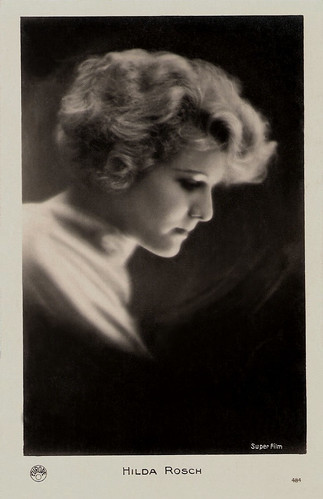
French postcard by Europe, no. 484. Photo: Super Film.
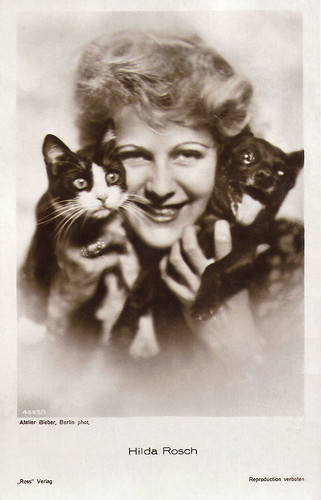
German postcard by Ross Verlag, no. 4665/1, 1929-1930. Photo: Atelier Bieber, Berlin.
Sources: Thomas Staedeli (Cyranos), Filmportal.de, Virtual History, Wikipedia and .

German postcard by Ross Verlag, no. 3595/1, 1928-1929. Photo: Aafa Film.

German postcard by Ross Verlag, no. 4054/2, 1929-1930. Photo: Atelier Jacobi, Berlin.
One of these little mysteries in the film history
Hilda Rosch must have been quite a popular film star as several postcards were produced with the beautiful actress.
Why Rosch then appeared in only eight films is one of these little mysteries of the film history.
Her first film was Die Zirkusprinzessin/The Circus Princess (Victor Janson, 1928) with Harry Liedtke, Trude Berliner and Cilly Feindt .
In the same year, Hilda Rosch appeared in the spectacular action films Der Unüberwindliche/The Invincible (Max Obal, 1928), and Tempo! Tempo! (Max Obal, 1929) opposite Italian strong man Luciano Albertini .
In Das Spiel mit der Liebe/The Game of Love (Victor Janson, 1929) she starred in a double role as Miss Lilian Tompson and as Marchesa Beatrice de Castellagain alongside Harry Liedtke .

German postcard by Ross Verlag, no. 4054/1, 1929-1930. Photo: Atelier Balázs, Berlin.

German postcard by Ross Verlag, no. 3642/2, 1928-1929. Photo: Aafa Film. Harry Liedtke and Hilda Rosch in Das Spiel mit der Liebe/The Game with Love (Victor Janson, 1928).

Belgian postcard by Weekblad 'Cinema', Antwerpen (Antwerp).
Abrupt End
Hilda Rosch's film career developed nicely. She appeared opposite cabaret star Max Hansen in the short Max Hansen: Jetzt geht's der Dolly gut/Max Hansen: Now Dolly Does Well (Max Reichmann, 1929).
In Die Warschauer Zitadelle/The Citadel of Warsaw (Jacob Fleck, Luise Fleck, 1930), she appeared with Hungarian actor Victor Varconi and the legendary La Jana .
But the new sound film seemed to hinder her career. She appeared in Ihr Junge/Her Boy (Friedrich Feher, 1931) with Feher’s wife Magda Sonja and their son Hans Feher in the leading parts.
Her last film was Der Bebende Berg/The Trembling Mountain (Hanns Beck-Gaden, Luitpold Nusser, 1931) in which she co-starred with director Hanns Beck-Gaden.
Then her film career ended abruptly. Because her voice did not suit the sound film? Because of the rise of the Nazis? Was she Jewish? We could not find more information about Hilda Rosch on the net.

French postcard by Europe, no. 484. Photo: Super Film.

German postcard by Ross Verlag, no. 4665/1, 1929-1930. Photo: Atelier Bieber, Berlin.
Sources: Thomas Staedeli (Cyranos), Filmportal.de, Virtual History, Wikipedia and .
Published on January 29, 2020 22:00
January 28, 2020
Monique Van Vooren (1927-2020)
Yesterday, 28 January 2020, Belgian-born model, singer and actress Monique Van Vooren (1927) passed away. She gained notoriety for her many celebrity appearances on the game and variety show circuit in the 1950s and 1960s. She became a cult star, best remembered for her role as Baroness Katrin Frankenstein in Flesh for Frankenstein (1973).
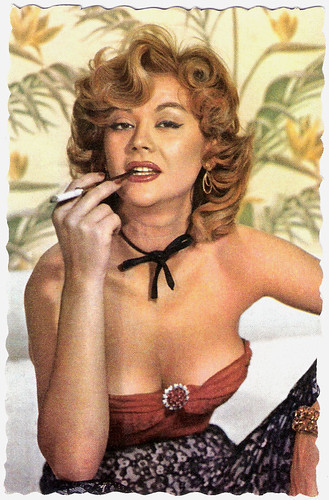
French postcard by De Marchi Frères, Marseille. Photo: Bernard of Hollywood.
Gorgeous Blonde
Monique Van Vooren was born in Brussels, Belgium in 1927 (some sources say 1925). Her parents were George Bronz (or Bronze) and Louise van Vooren. She later adopted her mother's maiden name as her professional name.
She reportedly studied philosophy and languages and learned to speak English, Italian, French, German, Spanish, and Dutch. She started her career as a model and was photographed for Life magazine.
Her first film was the Italian production Domani è troppo tardi/Tomorrow is Too Late (Léonide Moguy, 1950) starring Pier Angeli . She became a naturalised United States citizen in 1951.The gorgeous blonde soon got a Hollywood contract and had a supporting part in Tarzan and the She-Devil (Kurt Neumann, 1953) starring Lex Barker .
In France she played the leading lady-in-distress in Série Noire/Black Edition (Pierre Foucaud, 1954), based on a series of popular paperback adventures of the same title. Hal Erickson at AllMovie calls it “an acceptable Gallic imitation of America's hard-boiled detective genre. Henri Vidal plays the anti-hero, who moves with ease through the Parisian underworld.” She also appeared opposite tough guy Eddie Constantine in Ça va barder/Give 'em Hell (John Berry, 1955).
Back in Hollywood, she appeared in a small role in the musical comedy Ten Thousand Bedrooms (Richard Thorpe, 1957), Dean Martin's first solo film after his split with Jerry Lewis . She also played a bit part as a showgirl in the award winning musical Gigi (Vincente Minnelli, 1958) starring Leslie Caron , and had a role in the comedy Happy Anniversary (David Miller, 1959) with David Niven .
Van Vooren also performed on stage. On Broadway she played in John Murray Anderson's Almanac (1953) and in 1960 she appeared as Frenchy in the national tour of Destry Rides Again.
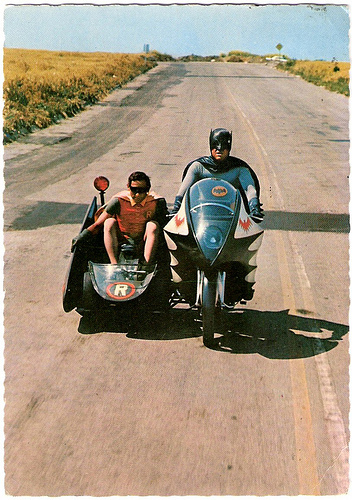
Dutch postcard by Vita Nova, Schiedam, no. 8/10/49. Sent by mail in 1967. Photo: National Periodical Publications Inc. Publicity still for the 20th Century-Fox Film Batman (1966).
Miss Clean
During the 1960s, Monique Van Vooren appeared incidentally in films such as the eccentric independent comedy Fearless Frank (Philip Kaufman, 1967) starring Jon Voight. Her few other credits of that decade include playing Miss Clean in two episodes of the television series Batman (1968).
She was better known as a 'wild' celebrity, who attracted more attention with her private life than with her films. Jack Gaver wrote in The Gazette about her appearance at the premiere of the rock musical Hair in April 1968: “One of those who was not outdone by onstage proceedings was actress Monique Van Vooren, who showed up wearing a transparent black chiffon blouse with nothing but Monique beneath it.”
She returned to Europe where she appeared as the Queen of Skulls in Il Decamerone/The Decameron (1970), the first of director Pier Paolo Pasolini's ‘trilogy of life.’ The film was based on the sexually charged tales of 'Boccaccio'.
Her most memorable role was Baroness Katrin Frankenstein in Flesh for Frankenstein (Paul Morissey, 1973), starring Udo Kier and Joe Dallesandro. Andy Warhol was one of the co-producers of the film, but it was filmed in Cinecittà with an Italian film crew. In the USA, the film was marketed as Andy Warhol's Frankenstein, and was presented in the Space-Vision 3-D process in premiere engagements. The MPAA rated the film an X, due to its explicit sexuality and violence.
Van Vooren also played that year opposite Elizabeth Taylor in Ash Wednesday (Larry Peerce, 1973), and with Mary Woronow in the erotic thriller Sugar Cookies (Theodore Gershuny, 1973). Sugar Cookies was an early production credit for both Oscar-winner Oliver Stone and Troma Entertainment honcho Lloyd Kaufman.
She worked again with Stone on his Wall Street (Oliver Stone, 1987) starring Michael Douglas. Stone’s son Sean Stone later cast her for his horror film Greystone Park (Sean Stone, 2012).
Monique Van Vooren passed away on 29 january 2020. She was 92. According to Wikipedia , her first visit to the United States apparently took place in 1946 at age 19, with the married name "Jakobson" and listed as a "housewife". Her second husband was Kurt (or Curt) Henry Pfenniger, whom she married in 1950. Her third husband was New York businessman Gerard Walter Purcell. The couple were married from 1958 until Purcell's death in 2002. They had one child.
Trailer for Tarzan and the She-Devil (1953). Source: pwgr2000 (YouTube).
Trailer for Flesh For Frankenstein (1973). Source: Pendulum House (YouTube).
Sources: Hal Erickson (AllMovie), Kurt Gardner (Weird Movie Village - now defunct), Jack Gaver (Gazette), Muppet Wiki, Les gens du Cinema (French), Wikipedia and .

French postcard by De Marchi Frères, Marseille. Photo: Bernard of Hollywood.
Gorgeous Blonde
Monique Van Vooren was born in Brussels, Belgium in 1927 (some sources say 1925). Her parents were George Bronz (or Bronze) and Louise van Vooren. She later adopted her mother's maiden name as her professional name.
She reportedly studied philosophy and languages and learned to speak English, Italian, French, German, Spanish, and Dutch. She started her career as a model and was photographed for Life magazine.
Her first film was the Italian production Domani è troppo tardi/Tomorrow is Too Late (Léonide Moguy, 1950) starring Pier Angeli . She became a naturalised United States citizen in 1951.The gorgeous blonde soon got a Hollywood contract and had a supporting part in Tarzan and the She-Devil (Kurt Neumann, 1953) starring Lex Barker .
In France she played the leading lady-in-distress in Série Noire/Black Edition (Pierre Foucaud, 1954), based on a series of popular paperback adventures of the same title. Hal Erickson at AllMovie calls it “an acceptable Gallic imitation of America's hard-boiled detective genre. Henri Vidal plays the anti-hero, who moves with ease through the Parisian underworld.” She also appeared opposite tough guy Eddie Constantine in Ça va barder/Give 'em Hell (John Berry, 1955).
Back in Hollywood, she appeared in a small role in the musical comedy Ten Thousand Bedrooms (Richard Thorpe, 1957), Dean Martin's first solo film after his split with Jerry Lewis . She also played a bit part as a showgirl in the award winning musical Gigi (Vincente Minnelli, 1958) starring Leslie Caron , and had a role in the comedy Happy Anniversary (David Miller, 1959) with David Niven .
Van Vooren also performed on stage. On Broadway she played in John Murray Anderson's Almanac (1953) and in 1960 she appeared as Frenchy in the national tour of Destry Rides Again.

Dutch postcard by Vita Nova, Schiedam, no. 8/10/49. Sent by mail in 1967. Photo: National Periodical Publications Inc. Publicity still for the 20th Century-Fox Film Batman (1966).
Miss Clean
During the 1960s, Monique Van Vooren appeared incidentally in films such as the eccentric independent comedy Fearless Frank (Philip Kaufman, 1967) starring Jon Voight. Her few other credits of that decade include playing Miss Clean in two episodes of the television series Batman (1968).
She was better known as a 'wild' celebrity, who attracted more attention with her private life than with her films. Jack Gaver wrote in The Gazette about her appearance at the premiere of the rock musical Hair in April 1968: “One of those who was not outdone by onstage proceedings was actress Monique Van Vooren, who showed up wearing a transparent black chiffon blouse with nothing but Monique beneath it.”
She returned to Europe where she appeared as the Queen of Skulls in Il Decamerone/The Decameron (1970), the first of director Pier Paolo Pasolini's ‘trilogy of life.’ The film was based on the sexually charged tales of 'Boccaccio'.
Her most memorable role was Baroness Katrin Frankenstein in Flesh for Frankenstein (Paul Morissey, 1973), starring Udo Kier and Joe Dallesandro. Andy Warhol was one of the co-producers of the film, but it was filmed in Cinecittà with an Italian film crew. In the USA, the film was marketed as Andy Warhol's Frankenstein, and was presented in the Space-Vision 3-D process in premiere engagements. The MPAA rated the film an X, due to its explicit sexuality and violence.
Van Vooren also played that year opposite Elizabeth Taylor in Ash Wednesday (Larry Peerce, 1973), and with Mary Woronow in the erotic thriller Sugar Cookies (Theodore Gershuny, 1973). Sugar Cookies was an early production credit for both Oscar-winner Oliver Stone and Troma Entertainment honcho Lloyd Kaufman.
She worked again with Stone on his Wall Street (Oliver Stone, 1987) starring Michael Douglas. Stone’s son Sean Stone later cast her for his horror film Greystone Park (Sean Stone, 2012).
Monique Van Vooren passed away on 29 january 2020. She was 92. According to Wikipedia , her first visit to the United States apparently took place in 1946 at age 19, with the married name "Jakobson" and listed as a "housewife". Her second husband was Kurt (or Curt) Henry Pfenniger, whom she married in 1950. Her third husband was New York businessman Gerard Walter Purcell. The couple were married from 1958 until Purcell's death in 2002. They had one child.
Trailer for Tarzan and the She-Devil (1953). Source: pwgr2000 (YouTube).
Trailer for Flesh For Frankenstein (1973). Source: Pendulum House (YouTube).
Sources: Hal Erickson (AllMovie), Kurt Gardner (Weird Movie Village - now defunct), Jack Gaver (Gazette), Muppet Wiki, Les gens du Cinema (French), Wikipedia and .
Published on January 28, 2020 22:00
Paul van Yperen's Blog
- Paul van Yperen's profile
- 13 followers
Paul van Yperen isn't a Goodreads Author
(yet),
but they
do have a blog,
so here are some recent posts imported from
their feed.



